Don't wanna be here? Send us removal request.
Text
Những món rau rừng đặc sản của Bắc Kạn
Đến với Bắc Kạn, ngoài việc ngao du khám phá danh lam thắng cảnh, ngắm cảnh đẹp non nước hữu tình, Bắc Kạn còn có những đặc sản dân tộc đặc trưng khiến bước chân lữ khách du lịch nơi đây phải lưu luyến.
Nếu ai đã từng đến thăm mảnh đất vùng cao Bắc Kạn nổi tiếng với những địa danh thắng cảnh như Hồ Ba Bể, rừng nguyên sinh, với những điệu hát then, nghỉ ngơi một đêm bên bếp lửa nhà sàn và thưởng thức sản vật của núi rừng Bắc Kạn hẳn sẽ không thể quên được hương vị đặc trưng riêng được chế biến từ bàn tay khéo léo của người dân nơi đây.
Rau Dớn
Rau dớn l�� một loại cây thuộc họ quyết, giống như cây dương xỉ, cành dài lá nhỏ, mặt lá có màu xanh nhẵn, cuống lá có lông. Ở Bắc Kạn, rau dớn thường mọc ở vùng núi cao, nơi ngọn nguồn của các con sông, con suối và thường mọc ở bờ suối, bờ khe, nơi có độ ẩm ướt cao. Rau dớn ăn ngon nhất là sau mùa lụt đến cuối mùa xuân. Lá rau dớn non uốn cong như vòi voi, có nhựa nhớt, cây xanh tươi tốt quanh năm. Đồng bào thường chỉ hái ngọn cong non, lá bánh tẻ để chế biến món ăn.
Xem thêm Những món ăn đặc sản Điện Biên
Đồng bào dân tộc ở Bắc Kạn có thể chế biến các món ăn độc đáo từ rau dớn như: Rau dớn xào tỏi, rau dớn xào cùng nước măng chua… nhưng món ngon nhất phải kể đến món nộm. Món nộm rau dớn chỉ cần vài mớ rau, lạc rang giã nhỏ, chanh và một số loại rau thơm như húng, mùi tàu, ớt, tỏi và một chút muối, mì chính. Sau khi hái về nhặt lấy phần rau non, bỏ phần già, rửa sạch rồi cho vào luộc chín tới, vớt ra bỏ rau vào bát to, cho rau thơm, ớt, gừng, tỏi, nước chanh tươi, mì chính và muối trắng trộn đều. Để khoảng 5 phút cho ngấm gia vị, sau đó cho lạc rang giã nhỏ vào là có thể ăn ngay được. Món nộm rau dớn khi ăn sẽ cảm nhận được mùi thơm đặc trưng của các loại rau, vị bùi của rau dớn, vị chua ngọt xen lẫn một chút vị cay của ớt.
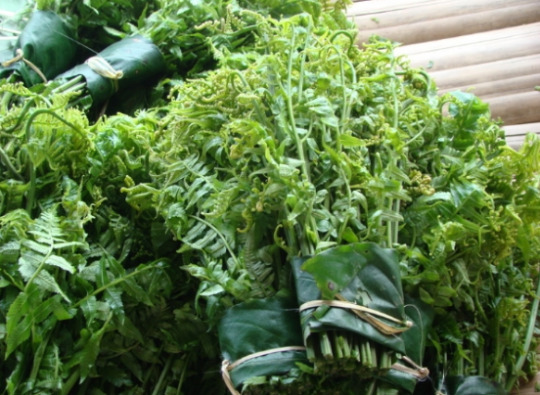
Là loại rau rừng, dễ tìm và sạch, rau dớn còn có tính mát, lợi tiểu, chống táo bón, làm ngưng các cơn đau âm ỉ do viêm đại tràng, giúp dễ ngủ, giúp cơ thể khoẻ mạnh nên rất được đồng bào ở Bắc Kạn ưa chuộng.
Rau Bồ Khai
Rau Bồ Khai thường mọc trên những vùng núi đá cheo leo, ngọn rau giống như cây tầm gửi, thân bám vào những cây gỗ lớn để vươn lên đón lấy cái trong trẻo của ánh sáng và khí trời. Ngọn rau thoạt nhìn giống ngọn mướp hương nhưng mảnh mai hơn và có màu xanh non tơ như lá cành mới nhú. Khoảng mùa xuân, bồ khai bắt đầu trổ ngọn xanh tốt. Người dân trong vùng đã quen với mùa đi hái Bồ Khai. Vào dịp này, ở khắp các phiên chợ vùng cao nơi đây đều có bày bán rau Bồ Khai.
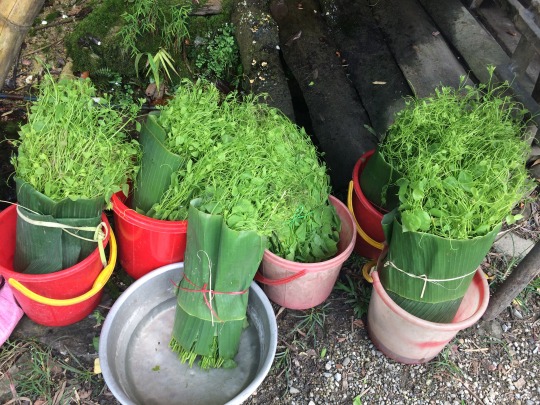
Bồ Khai mang về chẳng phải chế biến cầu kì gì nhiều, chỉ cần nhặt sạch, phi tỏi thơm trên bếp rồi đổ rau vào xào to lửa là đã có một món rau hấp dẫn, xanh mướt, thơm giòn…Bồ Khai còn được dùng làm món phở xào, mì xào hay xào lẫn với thịt bò, sào với trứng gà. Rau Bồ Khai có một mùi vị rất riêng, không thể tìm được sự tương đồng ở bất cứ loại mùi vị nào khác.
Rau Ngót rừng
Không giống như các loại rau khác chỉ cần trồng ngày một ngày hai là được hái lá, rau ngót rừng từ khi trồng đến khi được hái lá lần đầu tiên phải sau ít nhất là 3-5 năm và sau 10 năm mới được thu hoạch với số lượng lớn.
Đây là một loại rau có mầu xanh thẫm, óng ả, ra hết lớp này đến lớp khác và ra nhiều nhất vào tháng Hai, tháng Ba âm lịch hằng năm. Lá rau dùng để nấu canh với thịt hoặc cá. Mùi vị của loại rau này rất đậm đà, chỉ cần một vài cọng cũng đã đủ để nấu bát canh thơm ngon cho bốn người ăn. Những cây rau ngót rừng đực cho những chùm rồng rồng, có thể dùng để nấu canh và ngon hơn nữa là xào với thịt bò.
Xem thêm Mắc khén - gia vị độc đáo của núi rừng Tây Bắc
Cách chế biến các món ăn từ rau ngót rừng cũng khá là đơn giản nếu không có điều kiện để nấu với thịt, cá thì có thể nấu suông cũng khá là ngon, chậm rãi nhai kỹ từng chiếc lá nhỏ, thưởng thức thật sâu, thật kỹ vị ngọt, vị bùi khó tả của nó thì mới thấy được hương vị đặc biệt của cây rau ngót rừng và cảm nhận được sự thuần khiết của núi rừng.
0 notes
Text
Món gỏi cá độc lạ của người Thái
Cá tự nuôi vừa đủ cung cấp cho gia đình, vừa đảm bảo vệ sinh. Ngoài cá ao, đồng bào còn đánh bắt thêm cá suối. Cá suối thường có hương vị thơm ngon hơn nên rất được đồng bào ưa chuộng. Từ cá có thể chế biến thành nhiều món: cá kho, rán, nướng, gỏi hoặc làm khô để dự trữ. Trong đó, độc đáo nhất phải kể đến món cá nhảy, một món ăn không phổ biến và khá lạ lẫm đối với nhiều người.
Món cá nhảy tuy chế biến khá đơn giản nhưng lại rất kén người ăn nên không được phổ biến. Món này có điểm tương đồng với món gỏi cá nhưng lại có điểm khác biệt là gỏi thì dùng thịt thái lát từ cá có kích thước lớn còn món cá nhảy thì chỉ dùng loại cá bé bằng ngón tay. Điểm khác biệt lớn nhất có lẽ là cách ăn lạ lùng của món ăn này.
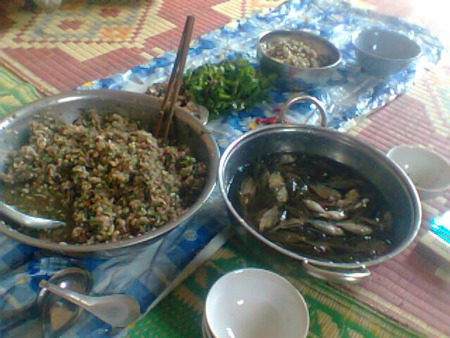
Nguyên liệu chính là cá nhưng loại cá dùng để chế biến món cá nhảy thì không phải dễ kiếm. Để làm món này, đồng bào phải dùng loại cá được nuôi ở ao tự nhiên hoặc bắt ở suối nguồn, cách xa khu dân cư. Cá ở những nơi đó mới sạch sẽ, thịt thơm ngon. Cá bắt về phải còn sống, chọn những con cá bé, có kích thước lớn nhất là bằng ngón tay cái của người lớn, thả vào chậu nước sạch, thấy cá còn bơi khoẻ là đạt yêu cầu.
Bước tiếp theo là chế biến món ăn kèm. Món này khá đơn giản nhưng yêu cầu phải đầy đủ nguyên liệu. Bao gồm lõi chuối tươi, rau thơm (mùi, húng, thì là, kinh giới…), các loại gia vị mắm, muối,mỳ chính, tỏi, ớt và đặc biệt là không thể thiếu hạt mắc khén (gia vị đặc biệt của người Thái). Lõi chuối thái mỏng, băm nhỏ, rau thơm, ớt tỏi băm nhỏ đem trộn đều với lõi chuối, nêm gia vị, cho nước măng chua ngập sâm sấp. Yêu cầu của hỗn hợp ăn kèm này là có độ chua vừa đủ nhưng phải cay, nồng và có mùi thơm đặc trưng.
Xem thêm Khám phá món nướng độc đáo Pa Pỉnh Tộp
Khi tất cả đã ngồi vào mâm, chủ nhà mới bắt từng con cá từ trong chậu, dùng dao nhỏ khía nhanh vào bụng cá, nặn ruột bỏ ra ngoài rồi thả nhanh vào hỗn hợp chuối vừa chuẩn bị. Người mổ cá phải nhanh, khéo sao cho khi mổ xong cá vẫn còn sống. Mỗi người ăn dùng một chiếc thìa nhỏ xúc cá kèm theo lõi chuối và nước chua đưa lên miệng thưởng thức. Cá mổ đến đâu thì ăn đến đó, ăn khi cá còn sống, thả ra còn có thể dẫy được, như vậy thịt mới giòn ngọt, không có mùi tanh.
Cá dùng làm món này được lựa chọn kỹ. Đó phải là loại cá sống ở môi trường hoàn toàn tự nhiên nên rất sạch sẽ. Còn khi ăn, cá đã được bỏ ruột, khi thả vào hỗn hợp lõi chuối khiến thịt cá săn lại ngay vì đồ ăn kèm đủ vị chua và đặc biệt là rất cay, món này không khác gì món gỏi cá.
Nguyên liệu đảm bảo yêu cầu thì sẽ khiến người ăn cảm nhận được rất nhiều mùi vị khác nhau của món ăn này. Có vị giòn, ngọt của thịt cá và lõi chuối, vị chua của nước măng, vị cay của tỏi, ớt, vị tê tê nơi đầu lưỡi và mùi thơm nồng của hạt mắc khén. Với những người chưa từng biết món cá nhảy thì đây quả là món ăn lạ lùng, rất khó có thể thử ăn để cảm nhận hương vị. Còn đối với người Thái thì món ăn này rất đặc biệt, nó tô điểm cho ẩm thực Thái thêm phong phú và đa dạng.
Xem thêm Những món rượu ngon không thể bỏ qua của Tây Bắc
0 notes
Text
Những món ngon khó quên của người Cao Bằng (P2)
Các món từ ong vò vẽ
Ong vò vẽ là một loại ong có nọc độc nổi tiếng là hung dữ và nguy hiểm, thế nhưng, ở Cao Bằng, loại ong này đang được chế biến thành nhiều món ăn đặc sắc mang đậm dấu ấn và bản sắc dân dã…
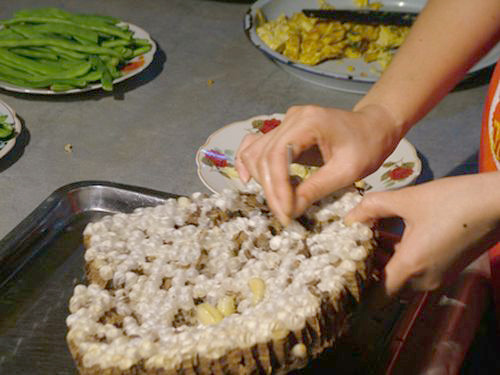
Nhộng ong sau khi được tách ra khỏi tổ thân tròn, béo mập rất mềm và trắng mọng. Để món ăn được ngon thì phải xào với măng chua, ăn vừa béo, giòn, ngọt, chua, theo mọi người nói có lẽ là món ăn làm từ côn trùng ngon nhất. Ngoài món ong xào măng còn có món ong nấu cháo. Vào mùa thu chính là mùa ăn ong tại Cao Bằng. Ong được bắt cả ổ, con lớn thì bán hay ngâm rượu, con nhỏ thì để chế biến món ăn.
Đậu phụ
Cao Bằng là một nơi có khí hậu trong lành, nhờ chất đất tốt nên Cao Bằng có thế mạnh trồng đỗ tương chất lượng cao. Hạt đỗ tương giàu chất dinh dưỡng. Do đó, khi chế biến đỗ tương sẽ giúp cho thức ăn có mùi thơm ngon, béo ngậy. Cách làm đậu phụ của người Cao Bằng hết sức cầu kỳ.
Xem thêm Mắc khén - đặc sản của núi rừng Tây Bắc
Từ miếng đậu ngon, người Cao Bằng thường chế biến thành các món ăn khác nhau giàu chất dinh dưỡng như: đậu rán sốt cà chua, đậu chấm nước mắm chanh hoặc mắm tôm, đậu cắt miếng, rưới nước sốt cà chua và thịt băm, đậu rán xốt thịt ba chỉ, đậu phụ xị, váng đậu để ăn lẩu, tàu phớ…
Phở chua
Phở chua Cao Bằng không chỉ là đặc sản của miền sơn cước mà còn được liệt vào danh sách những món ăn đặc sản Việt Nam. Là món ăn nguội, phở chua được yêu thích khi ăn vào vào mùa thu và mùa hè.
Phở chua Cao Bằng ngon bởi vì bánh có độ dẻo, kết hợp với độ béo của thịt ba chỉ, vịt quay và còn có vị ngậy của mỡ vịt, vị chua cay của măng ớt… Ăn vào lúc thời tiết hơi lạnh thì thấy rất ấm áp, mùa nóng lại có cảm giác mát lạnh. Khi ăn hết tô, có vị chua đọng lại nên vẫn cảm thấy thèm ăn thêm. Ăn lần đầu còn lạ miệng, đến lần thứ hai, ba bạn sẽ cảm thấy nghiện hương vị độc đáo của nó.
Bánh trứng kiến
Không phải trứng của loại kiến nào cũng có thể ăn được. Chỉ có trứng của kiến đen (thường được người Tày gọi là tua rày) có thân hình nhỏ, đuôi nhọn mới ăn được. Vì vậy, cứ vào khoảng tháng 4-5, người dân tộc Tày tỉnh Cao Bằng lại cùng nhau vào rừng tìm trứng kiến đen mang về làm bánh. Bánh trứng kiến đen được làm từ bột nếp và lá non cây vả. Trứng kiến đen rất béo, có hàm lượng protein cao.

Trứng kiến đen không chỉ được chế biến thành bánh trứng kiến mà còn làm xôi trứng kiến, bánh dày hoặc đem phi thơm với hành, ăn cùng với cơm thì rất ngon.
Một chiếc bánh trứng kiến ngon có các vị béo ngậy, vị của hành, vị của lá vả. Nhưng không phải ai cũng ăn được nên có một số người sẽ bị dị ứng nhẹ nếu không hợp.
Rau dạ hiến
Rau dạ hiến hay còn gọi là rau bồ khai, tiếng Tày – Nùng gọi là Phjắc diển, thường mọc hoang ở vùng núi đá. Ðây là loại cây thân dây rất giòn, dễ gãy. Thân được chia làm nhiều nhánh to bằng đầu đũa bám trên các cây gỗ để đón ánh sáng mặt trời. Dù là thứ rau dại, mọc hoang nhưng rất hiếm nơi có. Vì thế, khoảng thời gian từ tháng hai đến tháng bảy âm lịch, nếu như có ai vào rừng hái được một nắm rau dạ hiến là cảm thấy rất quý.
Dạ hiến trở thành một thứ rau đặc sản Cao Bằng. Vào dịp mùa xuân và mùa hè, ở những vùng thị xã cũng như ở các nơi khác, hầu như không có bữa tiệc nào là không có món rau dạ hiến được xào với thịt bò, lòng lợn, lòng gà. Quả thực đây là một món ăn rất ngon dường như chỉ có ở Cao Bằng. Món rau rừng này có hương vị rất lạ lùng, không giống bất kỳ một loại rau nào khác bởi hương vị đặc biệt quyến rũ khó quên.
Vịt quay 7 vị
Vịt quay 7 vị là đặc sản ở Cao Bằng. Được gọi là món vịt quay 7 vị vì người Cao Bằng đã dùng 7 loại gia vị khác nhau để ướp món thịt vịt.
Sau khi quay xong thịt vịt được chặt nhỏ ra đĩa, da vàng màu mật, rộm cánh gián. Thịt ăn chắc và ngọt, mềm nhưng không bở, cũng không dai. Mỗi khi ăn người ta phải nhai thật chậm để cảm nhận hết vị ngọt của mật ong với vị béo của dầu, vị ngon của miếng vịt non đầu tháng.
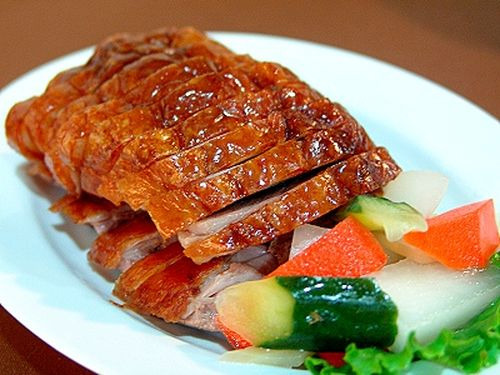
Bên trong từng miếng vịt quay là một mùi hương ngai ngái như mùi lá non, vị hơi đắng nhưng càng ăn càng ngọt thịt. Đó là do 7 thứ gia vị được lấy từ trong bụng vịt. Nhiều người từng được nếm qua đều đoán rằng trong các thứ gia vị ấy, có rất nhiều vị như là rễ, lá của cây được mang về từ trên rừng. Do đó, nhiều người muốn học được cách làm vịt quay Cao Bằng nhưng đều không thể có được mùi vị đặc trưng ấy.
Bánh áp chao
Mùa đông ở Cao Bằng có một món ăn rất đặc biệt, món ăn làm xua tan đi nhanh chóng cái lạnh miền rừng núi. Hình thù món ăn thoạt nhìn thì giống như bánh rán, nhưng không phải là bánh rán, người Cao Bằng gọi đó là áp chao.
Xem thêm Khám phá món nướng độc đáo Pa Pỉnh Tộp
Nguyên liệu để làm bánh áp chao gồm gạo tẻ, gạo nếp và thịt vịt. Người Cao Bằng khi ăn bánh áp chao không chỉ là ăn một món ngon mà còn là thưởng thức và cảm nhận cái tình cảm yêu thương lẫn nhau như sự hòa quyện của bột gạo tẻ, gạo nếp và thịt vịt.
Hạt dẻ Trùng Khánh
Hạt dẻ Trùng Khánh chỉ có ở Cao Bằng. Khách du lịch khi đến đây thường nhớ đến hạt dẻ vì nó là một loại quả thơm ngon nhất mà họ từng được thưởng thức.
Hạt dẻ có vỏ cứng, dày và có nhiều lông tơ. Có thể đem luộc, hấp hoặc mang vào lò nướng chín, bạn sẽ thấy có hương thơm tự nhiên. Chỉ cần ngậm một lúc, tự nó mềm ra như bột bánh. Hạt dẻ xuất hiện vào cuối mùa thu. Khi ăn hạt dẻ thơm ngon trong tiết trời lạnh bạn sẽ có thể cảm nhận được hương vị của núi rừng và tấm lòng của người chăm sóc cây dẻ.
0 notes
Text
Những món ngon khó quên của người Cao Bằng (P1)
Vùng đất Cao Bằng có quá nhiều những món ngon đặc sản khiến bạn khó có thể quên. Có những món bạn nên thưởng thức ngay trong chuyến đi nhưng có những món bạn có thể đem về làm quà cho bạn bè, người thân.
Miến dong đen
Từ lâu, người ta đã ví Nguyên Bình (Cao Bằng) là “đất miến”.
Với sự khéo léo và kinh nghiệm của những người dân nơi đây đã tạo nên những sợi miến bóng đẹp, giòn, dai, có hương thơm đặc trưng của bột dong mà không hề sử dụng bất kỳ loại hóa chất nào. Bát canh miến Nguyên Bình rất thơm ngon mà có thể không cần thịt, cần xương hầm, không cần tra nhiều gia vị, nhưng hương vị khó có nơi đâu sánh kịp.
Xem thêm Những món rượu ngon Tây Bắc
Trong mâm cỗ ngày Tết của người dân Việt Nam nói chung, bao giờ cũng có một bát canh miến. Và đối với người dân Cao Bằng, bát canh miến Nguyên Bình được nấu với thịt gà, kèm các loại mộc nhĩ, nấm hương đã là món ẩm thực truyền thống, nó không đơn giản chỉ là một món ăn, mà còn mang vị quê hương, góp phần làm cho những bữa cơm tất niên thêm đậm đà, ấm áp đầy tình thương.
Lạp xường hun khói
Lạp xường ở vùng cao thuộc tỉnh Cao Bằng được chế biến cầu kỳ hơn ở vùng đồng bằng. Người ta chế biến lạp xường bằng cách đem lòng lợn non rửa sạch nhiều lần, cuối cùng là rửa bằng rượu. Sau khi làm vệ sinh sạch sẽ, lòng lợn non được phơi khô rồi thổi hơi vào trở thành bong bóng, để làm vỏ bao bọc bên ngoài của lạp xường.
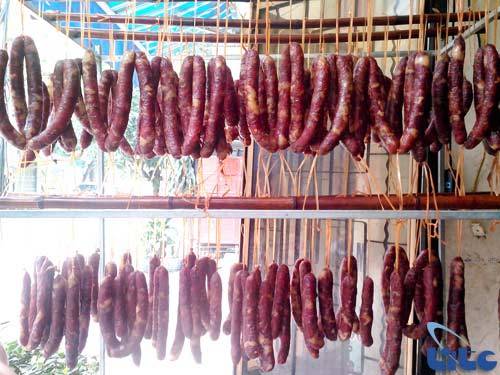
Nhân của lạp xường được làm bằng thịt thăn, thịt vai hoặc thịt mông lợn mán đen. Tất cả được băm nhỏ và tẩm ướp gia vị, mật ong, mía... và không thể thiếu một ít rượu trắng, một ít nước gừng và một ít quả mắc mật khô xay nhỏ ướp cùng. Rồi nhồi vào bong bóng để trở thành lạp. Công đoạn tiếp theo là phơi khô khoảng ba nắng rồi treo lên bếp lửa, khói và hơi nóng của bếp lửa nhen từ mía cho miếng thịt săn hơn và ngon hơn.
Nằm khâu
Nằm khâu một món đặc sản Cao Bằng là món ăn trong cỗ cưới của người Tày ở Cao Bằng. Món được nấu từ thịt ba chỉ và khoai, đem lại hương vị khó quên. Nằm khâu là món ăn chủ yếu có trong các cỗ cưới, rất gần gũi với người dân các huyện của tỉnh Cao Bằng.
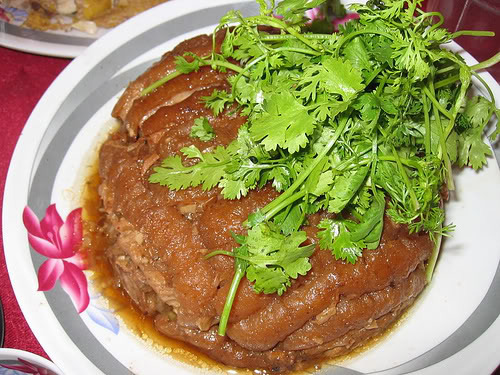
Món ăn phải luôn để nóng mới ngon. Không ít người lần đầu được thường thức, nhìn thấy miếng ăn to đã sợ ngấy, nhưng khi ăn rồi chỉ muốn được ăn thêm.
Cá chiên sông Gâm
Cao Bằng còn một đặc sản thuộc loại nổi tiếng, đó là con cá chiên sông Gâm. Loại cá lăng màu đen này vốn được một ông chủ quán chả cá Lã Vọng đánh giá là ngon nhất để làm chả cá. Lòng cá được người sành ăn cho là thứ ngon nhất trên đời.
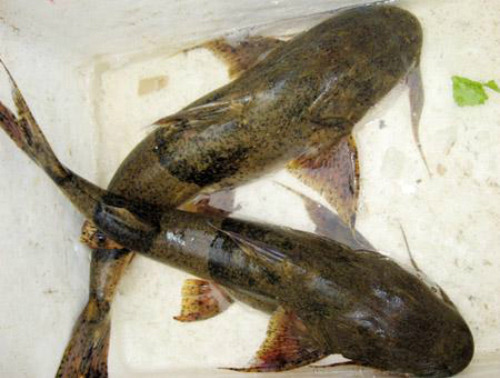
Cá chiên có con đến vài chục kg, là loại khó bắt vì chuyên sống trong hang ngầm dưới sông. Người đi câu thường đóng cả lán trại thường xuyên để đợi cá, đến khi câu được con nào là có người đến tận chỗ mua.
Bánh khảo
Bánh khảo có lẽ là một thứ lương khô của người Tày, Nùng ở Cao Bằng. Bánh khảo thường được làm vào dịp Tết. Có thể để lâu không mốc, thiu, nên với phong tục đón Tết trong những ngày xuân dài, thì khi nào nào trong nhà còn bánh khảo, thì chừng đó vẫn còn là Tết.
Làm bánh khảo đòi hỏi phải thật khéo léo. Khi làm bánh khảo thì ai có dụng cụ cũng có thể “làm được”, nhưng muốn “ăn ngon” thì thật là kiệt tác. Người làm bánh khảo khéo léo cũng chính là người nghệ nhân.
Bò gác bếp
Cao Bằng là nơi nuôi nhiều bò, tập trung nhiều nhất là các huyện Hà Quảng, Bảo Lạc, Bảo Lâm. Bò gác bếp Cao Bằng được tẩm ướp bằng các gia vị như muối, nước gừng, rượu trắng. Trước khi ướp, thịt được khía vài đường trên miếng thịt cho gia vị ngấm đều. Sau khi ướp xong dùng lạt tre tươi xâu thịt thành từng xâu rồi treo trên gác bếp.
Xem thêm Thắng cố - món ăn của người Tây Bắc
Bếp của người Tày, Nùng suốt ngày đêm lúc nào cũng có hơi lửa. Hơi lửa, hơi khói giúp cho thịt khô, săn cứng lại. Khoảng mười đến mười lăm ngày là đem xuống dùng được. Khi muốn mang xuống ăn phải ngâm trong nước nóng cho thịt nở ra, rửa sạch rồi thái ra thành từng lát mỏng. Chờ cho chảo nóng rồi đổ dầu vào, tiếp theo phi tỏi cho thơm rồi cho thịt vào đảo đều. Sau khi những lát thịt đã se se, đổ một ít nước vào om cho thịt mềm. Tỏi thì băm nhuyễn và gừng tươi thái chỉ đổ tất cả vào vào xào chung. Bây giờ thì hãy nêm gia vị cho vừa miệng và bây giờ chúng ta sẽ có đĩa bò gác bếp thơm lừng. Lát thịt bò có màu nâu đỏ, nhìn có vẻ khô nhưng lại rất mềm, hơi dai mà không bị xác, không bở, càng nhai càng thấy bùi.
Vị ngọt của thịt bò, vị cay thơm của gừng hòa quyện cộng với một ly rượu nhỏ nữa khiến cho món ăn trở nên càng tuyệt vời hơn.
Cá trầm hương
Đây là loài cá ngon trứ danh ở thác Bản Giốc, huyện Trùng Khánh (Cao Bằng).
Gọi là cá trầm hương bởi loài cá này thường ăn rễ, lá mục của cây trầm hương mọc ven sông Quây Sơn và Bắc Vọng. Chính vì vậy thịt chúng ngon hơn nhiều loại cá nào khác, khi ăn có thể cảm nhận được vị trầm.
Món ngon nhất từ loài cá trầm hương là nướng, vì giữ nguyên được mùi vị của cá, khiến người sành ăn cũng phải trầm trồ. Cá bắt từ sông, làm sạch, mổ bụng rồi nhét thêm một vài loại rau, gia vị như hành, thì là, ớt... vào bên trong, bọc qua bằng lớp lá chuối rồi cho lên bếp than nướng.
Khi chín, cá tỏa mùi thơm nức. Gỡ miếng cá chấm cùng chút nước mắm nguyên chất, cảm nhận vị thơm ngây ngất, phảng phất vị trầm khiến bạn sẽ nhớ mãi.
Xôi trám
Mùa thu, khi bạn có dịp vào các bản làng của người Tày bạn sẽ có dịp được thưởng thức món xôi trám.
Có hai loại trám: trắng và đen. Trám trắng thường dùng làm những thứ kẹo, mứt, đậu sị, ô mai và còn dùng để chữa ho và còn có tác dụng giải rượu. Trám đen dùng làm món kho, sốt đậu phụ, cá, có vị đậm đà. Nhưng muốn làm xôi trám thì chỉ có trám đen. Xôi trám làm đơn giản nhưng ăn rất tốt cho sức khỏe, thơm, bùi và béo ngậy. Nếu chưa có điều kiện làm xôi, khi hái về ngâm nước ấm, bóc lấy phần thịt rồi sấy sau đó đựng vào lọ để bảo quản.
0 notes
Text
Xem tướng bàn chân lõm của mỗi người
Tứ chi có liên quan đến tướng số như thế nào?
Trong thuật tướng số, tứ chi của con người có vai trò đặc biệt quan trọng, theo đó, từ hình dạng và những đặc điểm trên tứ chi chúng ta có thể quan sát vận mệnh và tính cách của một người nào đó. Đ��i với quan niệm của những người Á Đông thì con người cũng như một cành cây, chân tay cũng như cành nhánh của cây, vì vậy sẽ có cât tốt thân như xấu cành, cũng có cây sẽ xấu thân nhưng tốt cành. Nếu may mắn cả thân và cành nhánh đều tốt thì đó là điều đáng quý. Nếu tứ chi người nào đó hợp cách tức là tứ chi tương xứng với thân hình, hội tụ được các tiêu chuẩn mà tướng học đòi hỏi thì đây được xem là tương khả dĩ vi quý.
Xem thêm Giải mã nốt ruồi son trên cơ thể
Người có bàn chân lõm có khổ không? nói lên điều gì?
Nam giới thông thường sẽ thích mình có một bàn chân dày và nhiều thịt, trong đó có các độ dài bằng nhau, đây được xem là bàn chân của sự giàu sang, phú quý, tài lộc… Còn phụ nữ thì thích bàn chân mảnh mai, ít lộ xương ra mới được gọi là tướng tốt. Ngược lại những ai sở hữu bàn chân mà gầy yếu thì đây là người khổ ải, nghèo hèn.
Những người có lòng bàn chân mềm mịn và nhiều đường vân thì được xem là những bàn chân của người giàu sang phú quý, lan bàn chân mà thô cứng không có đường vân là tướng người bần cùng, lòng bàn chân mà có xuất hiện vân rùa thì là người thường phải đứng ra gánh vác các trọng trách. Đặc biệt gan bàn chân có vân như thêu gấm thì đây là người có rất nhiều lộc, của cải, gặp được nhiều may mắn… shop bán http://quanaobigsize.net/dam-cho-nguoi-map-60kg.html 60kg giá rẻ

Còn những người có lòng bàn chân lõm được xem là những người có tướng số rất tốt, thường sẽ được hưởng phúc lớn, không chỉ đối với gia đình mà bản thân họ cũng rất tốt, sức mạnh tài chính rất cao, nhúng người sở hữu lòng bàn chân lõm sẽ có được tài lẫn phúc. Ngoài ra, lòng bàn chân lõm kết hợp với bàn chân mềm mại thường có tướng phú quý. Người có vân chân tròn ở gót thường để phúc đức cho con cháu, vân chân hình xoắn ốc là người có danh tiếng, là người chính nhân quân tử…
Xem thêm Tìm hiểu ý nghĩa nốt ruồi trên cơ thể nữ giới
Hy vọng qua bài viết Người có bàn chân lõm có khổ không? nói lên điều gì? đã chia sẻ được cho các bạn những thông tin có ích và thú vị, qua bài viết này bạn cũng có thể tự nhận biết được bản thân mình cũng như người thân bạn bè, tuy nhiên tất cả chỉ là những phương thức, thuật bói tướng được người xưa để lại và không có cơ sở chứng minh. số mệnh và tương lai cũng một con người còn phụ thuộc khá nhiều vào môi trường sống và sự cố gắng của bản thân. Chúc bạn và gia đình luôn khỏe và thật nhiều niềm vui trong cuộc sống nhé!
0 notes
Text
10 món ngon đặc sản Mộc Châu
Đặc sản Mộc Châu nổi tiếng phải kể đến 10 món ngon, nức lòng bất kỳ du khách nào ghé đến đây yêu thương và nhớ mãi. Người ta sẽ phải ngỡ ngàng, trầm trồ trước văn hóa ẩm thực đặc sắc của vùng núi Tây Bắc này.
Trong vô vàn món ăn ngon của đặc sản Mộc Châu, Sơn La người ta sẽ phải nhắc mãi các món:
1. Bê chao
Đưa lên hàng đầu, bởi đây là mấy món ăn dân dã nhất trong những bữa cơm mỗi du khách đến Mộc Châu. Cốt yếu độ ngon của nó chính là ở chỗ “nóng”: miếng bê chao ăn ngay khi vừa ráo mỡ khỏi chảo khác hoàn toàn với khi để nguội: nó mềm, ngọt, thơm ngậy hơn rất nhiều. Hơi nóng của miếng thịt, thêm vài miếng gừng già quyện với nước tương ngọt lừ khiến ta ngây ngất.
2. Cá suối
Đặc sản Mộc Châu cũng thêm phong phú bởi món cá suối nướng. Cá suối nướng ở Mộc Châu là món ăn khoái khẩu của nhiều du khách bởi cá không bị tanh, tuy bé nhưng có thể ăn cả thịt lẫn xương và hương vị thì thơm nồng hấp dẫn. Sau khi rửa sạch, cá được mổ để vứt bỏ mật và ruột, sau đó ướp cùng mắc khén, rau thơm rừng, sả, ớt… và dùng thanh tre kẹp chặt, nướng trên than củi chừng 15 phút cho chuyển sang vàng ruộm là có thể dùng được.
3. Thịt trâu gác bếp
Thịt trâu gác bếp là món ăn đặc sản thường thấy trong bữa ăn của người Thái đen ở Mộc Châu. Món thịt này thường được làm từ bắp của những chú trâu, bò nhà thả rông trên các vùng núi đồi Tây Bắc. Khi làm, người ta lóc các thớ thịt ra thành từng miếng kiểu con chì và thái dọc thớ, ướp muối rồi hun khói trên gác bếp trong nhiều ngày để cho thịt trâu se lại cho các chất ngọt tụ vào trong thịt. Khi ăn đem nướng lại và xé ra thành sợi nhỏ để nhấm nháp cùng bia hoặc rượu ngô cay. Tuy nhiên, nếu không ăn quen bạn sẽ thấy lạ miệng với vị khói khá hắc và mặn của món ăn.
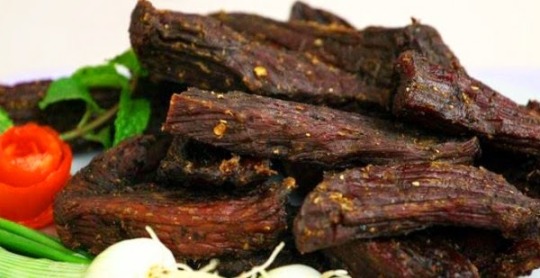
4. Nậm pịa
Là một món ăn đặc sản Mộc Châu, Sơn La, nậm pịa khá đặc biệt bởi mùi vị và màu sắc. Không phải vị khách nào khi du lịch đến Mộc Châu cũng đủ dũng cảm để thưởng thức món ăn này, tuy nhiên đây lại là món ăn yêu thích của người dân vùng cao. Nguyên liệu để tạo ra nậm pịa bao gồm tiết đông, sụn, đuôi, thịt, bạc nhạc, lục phủ ngũ tạng như lòng, dạ dày, gan và phần ruột non có chứa phân non của bò hoặc dê. Khi ăn thường kèm với hoa chuối, lá bạc hà… Nậm pịa là mồi nhậu thứ thiệt cho phái mày râu ở bản cao trong các phiên chợ ngày lạnh
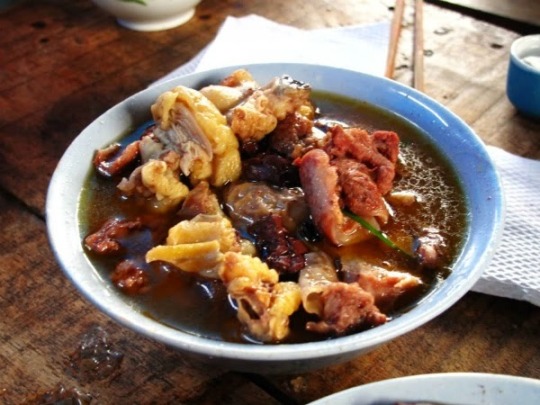
5. Khoai sọ mán
Một loại khoai dẻo thơm được người Dao vùng cao nguyên Mộc Châu trồng từ lâu và được coi là một loại đặc sản rất lạ ở đây.
Món khoai này thường được nấu với canh móng giò, xương sườn, nên rất hợp với dịp Tết. Thông thường khi gọt khoai, bạn nên gọt khô hoặc đi bao tay vào để tránh ngứa. Bổ củ khoai ra, bạn cũng nên rửa qua với nước muối loãng thì khoai bớt nhựa và khi nấu ăn sẽ không bị cảm giác bị ngứa trong cổ họng.
Ngoài ra, món khoai này còn có thể hấp, chiên như khoai lang, khoai tây ăn rất lạ miệng và hợp trong bữa cơm liên hoan ngày đầu năm mới.
6. Cải mèo
Rau cải mèo Mộc Châu ấn tượng nhất là cái vị đăng đắng ngăm ngăm vừa phải của nó. Đăng đắng qua rất nhanh để rồi khi qua đi, lại cảm nhận rõ thêm cái ngọt ngào, tươi non, mềm mại của rau; ngọt ngào, đậm đà của nước chấm. Thông thường, chế biến một cách đơn giản nhất, chỉ cần thái nhỏ, đập gừng đổ nước vào đun sôi là có một bát canh mát, rất hợp cho thực khách uống rượu, đặc biệt thích hợp trong thời tiết mùa đông. Cải mèo Mộc Châu ngoài ăn luộc còn có thể dùng ăn lẩu, xào với thịt hun khói, thịt gà… món nào cũng đặc sắc và có hương vị riêng. Nhưng ăn luộc chấm mắm dầm trứng vừa bình dị mà lại giữ được nhiều hương vị của cây cải mèo Mộc Châu nhất.
Mùa cải mèo Mộc Châu cũng đã tới. Nếu bạn đi Mộc Châu ngắm hoa, ngắm cảnh, lúc về đừng quên mua cho mình một ít rau cải mèo – thứ quà của núi rừng Tây Bắc về thưởng thức nhé.
Xem thêm Những món rượu ngon không nên bỏ qua của Tây Bắc
7. Cá hồi
Loại đặc sản này mới xuất hiện ở Mộc Châu vài năm nay, giá trị dinh dưỡng và độ ngon của nó thì khỏi phải bàn tới, nhưng cái thú ăn cá hồi ở Mộc Châu vào một ngày lạnh nó khác ăn vào mùa hè. Đó là khi món gỏi, món xông khói, hay chả… được chấm với bát nước chấm cay nồng mù tạt. Vừa xít xoa vì cay xộc lên mũi, vừa thấy người ấm hẳn lên. Những người ăn được cay quả là rất thú với món này, cay xộc, tê lưỡi nhưng sướng cái là không bị toát mồ hôi, người thấy thanh thanh chứ không bí bách vì nóng bức. Hiện có 2 nhà hàng cá hồi tại: tiểu khu Vườn Đào và nhà hàng cá hồi 64… Cá hồi có mức giá trung bình từ 200-250k/suất ăn.
8. Ốc đá Suối Bàng
Du lịch mộc châu thưởng thức Ốc đá ở Suối Bàng thường chỉ xuất hiện từ tháng 4 đến cuối tháng 8, tức là vào mùa mưa, khi thời tiết ẩm ướt. Những tháng còn lại chúng vùi mình trong những lớp lá dày hoặc nằm im dưới đất.
Những con ốc đá ở đây có hình dáng khá giống ốc núi bà Đen ở Tây Ninh. Chúng không phát triển theo chiều dọc như ốc nhồi, ốc bươu vàng mà theo chiều ngang, mình dẹp, to trung bình bằng hai đốt ngón tay, miệng loe ra có màu trắng sữa.
Ốc bắt về, người ta không xào ốc vì khi xào ốc ra nhiều nhớt ăn không ngon, mọi người thường nấu canh, hoặc đơn giản nhất là luộc với xả, ớt chấm mắm ớt. Con ốc khều ra quệt qua tí nước chấm bỏ vào miệng thấy cay cay đầu lưỡi, ốc chạm vào răng lại thấy giòn giòn, vị ngọt mát lan dần xuống cuống họng. Cái ngon ngọt, mát giòn của ốc đá là thế, không tanh mà còn có vị hăng, thơm của lá rừng…
Xem thêm Khám phá món nướng độc đáo Pa Pỉnh Tộp
9. Xôi ngũ sắc
Ở Mộc Châu, mỗi dân tộc đều có vốn văn hóa truyền thống đặc trưng tạo nên vườn hoa đầy hương sắc. Trong đó, văn hóa ẩm thực truyền thống của người Dao được thể hiện rõ nét qua hương vị của xôi ngũ sắc. Nguyên liệu làm xôi ngũ sắc gồm: gạo nếp thơm dẻo, hạt đều không lẫn tẻ, trộn với các loại lá cây rừng (co khảu, khảu đen) để nhuộm màu, tùy thuộc vào mỗi loại lá và cách pha chế để tạo ra 5 màu khác nhau, tạo ra sản phẩm sôi vô cùng hấp dẫn.
10. Sữa bò non Mộc Châu
Những đàn bò Mộc Châu mang đến cho người dân nơi đây các sản vật hết sức đặc biệt, trong đó phải kể đến sữa bò tươi. Ai đã từng được uống sữa bò đẻ (sữa đầu chỉ có trong vài ba ngày) mới thực sự là hạnh phúc. Bởi không phải lúc nào cũng có bò đẻ. Nó là thứ sữa nhiều chất dinh dưỡng, béo, ngậy và rất thơm. Sữa tươi có thể uống bất kể lúc nào nhưng có lẽ thời điểm buổi sáng se lạnh là tuyệt nhất, mùi sữa nóng thơm phức, hương vị béo ngọt làm ta thấy vô cùng ấm áp và sảng khoái.
Bên cạnh món sữa tươi hảo hạng thì người dân địa phương còn chế biến món sữa đông độc đáo. Sữa vắt ngay sau khi bò vừa đẻ, đem hấp cách thủy cho đông lại rồi xắt miếng ra chấm cùng muối ớt, mùi vì món ăn lạ miệng và ngon tuyệt. Ngoài ra các sản phẩm từ sữa bò cò có bơ, váng sữa hay sữa chua bẹo ngậy và rất thơm ngon. Nếu có dịp tới du lịch Mộc Châu, du khách đừng quên nếm thử các sản phẩm từ sữa bò nổi tiếng tại đây và mua về làm quà nhé.
0 notes
Text
Review Game Donkey Kong Country
Donkey Kong Country: Tropical Freeze on the Wii U in 2014, we gave it a 9.0, for Amazing. Here’s what we said about it then:
“Donkey Kong Country: Tropical Freeze is a great platformer full of tense sequences and tough levels. Boss battles are a huge highlight, and it’s packed with hard-to-find secrets and collectibles. Multiplayer could use some improvement, but I found myself laughing whenever my teammate and I wiped out on some of these unforgiving setups. But a rewarding sense of accomplishment stuck with me each time I overcame a new obstacle, and that feeling kept me going all the way to the end.”The Switch version maintains the difficulty and tough bosses, but adds a more accessible and fun Funky Mode, if you aren’t up for the soul-crushing challenges of some of Tropical Freeze’s later levels.
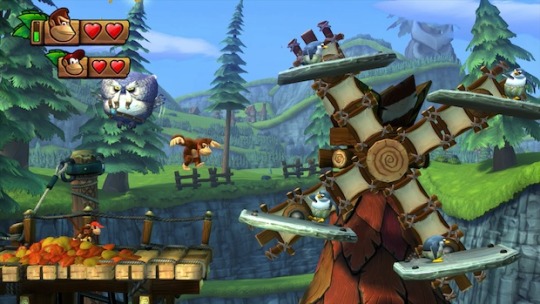
Tropical Freeze looks great on Switch. The excellent animation moves fluidly while docked or in handheld. I did find myself leaning in close during tense boss battles so I could better keep track of everything happening on screen, but portable Donkey Kong is excellent. I wouldn't recommend taking on some of the harder levels in public if, like me, you’re unable to stifle frustrated sighs even when surrounded by strangers.
The much more accessible Funky Mode is the biggest change to the Tropical Freeze formula, and it’s a welcome one because it makes things easier without feeling like a mode for babies. The precision jumps and timing are still there. You can’t cheese your way through any of the levels or battles, you just get a few extra chances to correct your mistakes. It lets you play as either Donkey Kong or the titular Funky Kong, the coolest of all the Kongs. With his wrap-around sunglasses, belt-fastened jorts, tank-top, and bandana, he’s the cool uncle who knows a lot about living, and a little about love. Thanks to a surfboard that lets you feather your falls, Funky’s jumps are much more forgiving than even the jumps possible with Diddy’s rocket or Dixie’s ponytail helicopter. Funky’s surfboard also makes him briefly immune to spike damage, and brings the total level of tubularness in the Switch version to a place unheard of on Wii U. He also needs no help from Diddy, Dixie, or Cranky. If that wasn’t enough to take the edge off the difficulty, Funky Mode also gives you an extra heart for each level, and hearts to replenish your health appear more often during levels.
News : Review Game Mount Blade 2: Bannerlord
About info of Game Crew 2
The controls are tight and jumps are easy to pull off, but I found playing in handheld mode harder than playing with the Pro Controller. I had difficulty with the smaller shoulder buttons on the Joy-Cons, used to pick up barrels and stunned enemies. Sometimes I’d accidentally throw something because there isn’t as much play in those shoulder buttons. Likewise, I struggled to beat the final boss with the Switch in handheld because picking up and throwing stunned enemies is a huge part of the process. Once I sat down on my couch with a controller, I… still struggled, but less so.
Difficulty in Tropical Freeze is unrelenting, but almost never feels cheap, with one major exception. One of the later rocket-barrel levels was so frustrating, it’s not only my least favorite level in Tropical Freeze, it’s one of my least favorite levels, ever. You’re required to navigate tiny, deadly corridors using the clunkiest controls in the game. I put it up there with the underwater dam level in the original TMNT for NES. I really hated it, and if I need to revisit it to 100-percent Tropical Freeze, well, I guess I won’t be 100-percenting it.
The boss battles, too, are difficult but fair. I never felt like I died because of some cheap move on the part of the game. I died because I just wasn’t good enough. And I wasn’t good enough A LOT, particularly on some of the later bosses. Thankfully extra lives by way of balloon are easy to come by. Funky sells them in his shop for the low price of just three coins, and there are plenty of other chances to pick up extra chances along the way.
0 notes
Text
Review Game Omensight
Omensight is a game about furry, humanoid, animal things that are all trying to murder each other for various political reasons. The whole spectacle of it is absolutely adorable right up until the moment that it chooses not to be.
The story revolves around several kingdoms, each made up of a specific species, who have found themselves locked into a huge power struggle. The problem is that there are bigger fish to fry. A giant, apocalypse-inducing demon named Voden is trying to destroy all life as we know it, and that’s where the player character comes in. You are The Harbinger, a silent, goofy-looking, glowing creature who has the power to travel back in time. Your journey is spent reliving the same twenty-four hours over and over with the hopes of figuring out how to stop this huge demon jerk from committing a widespread genocide of all sentient beings.For the first couple of hours, I had trouble looking past the subpar voice acting. Everyone just seemed like cliché, cookie-cutter bullshit. Then something wonderful happened. With each new story reveal, the characters evolved, and by the end, they proved that their actions and personalities had a genuine amount of nuance to them. I found myself, despite my initial reservations, becoming rather invested in how events played out.
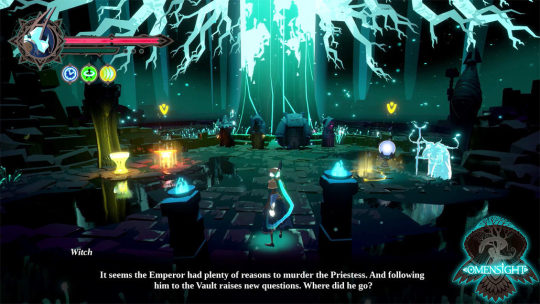
Once you’ve made it past the introduction sequences, you’ll find yourself in a hub world where you can choose to start the day alongside one of four characters. After you’ve gained a key piece of knowledge from one character’s perspective, however, you can show that to others, which will dramatically impact how things play out. Zig-zagging your way across timelines, you’ll eventually piece together the mystery of what actually happened.
Slowly but surely, you’ll fight your way to the truth. Sometimes, this involves doing the “wrong” thing, with the hopes of gaining some new scrap of knowledge, in order to progress the story. Sometimes, this makes you feel like a total asshole. It’s for the greater good though, right?
The combat is your basic hack ‘n slash affair, but there are a few different elements that keep things fresh. If you dodge an enemy attack at just the right moment, it’ll slow down time, but you also have a separate ability that can slow down time even longer, a dash, a grab/throw mechanic, and a few other offensive capabilities. These are all limited by a cooldown timer, so you can’t just spam them. The ways that you mix and match these skills is where the real fun lies. It’s a simple system, but it works.
News Review game Plague Tale Innocence
Hot game Mount Blade 2: Bannerlord
Unfortunately, the combat suffers from a decent amount of float, and it can be difficult to tell which enemy you’re targeting at any given time. These same issues affect platforming segments as well, and all of this is exacerbated by the absolutely ancient implementation of a fixed camera perspective.
Just in case I’m not making myself clear, this is definitely a budget title, and it has more than its fair share of rough edges. The actual gameplay maintains a mostly acceptable framerate, but the loading screens dip into straight-up shameful territory. Besides being a frequent nuisance, the animations will freeze, and I was forced to restart the game several times as a result. The weirdest part was that it never happened while I was playing. It was always when I was helplessly staring at a stubborn loading bar. Hopefully, this sort of stuff will be addressed in the planned day-one update, but for now, it’s pretty disappointing.
Outside of the interesting narrative structure, there’s not a whole lot here that you haven’t seen before. Everything, from artwork to combat, is presented in a way that’s just barely competent enough to keep things interesting. You can see how all of the elements have been shoddily pasted together, but when all is said and done, it’s still somehow a great fucking game.
Omensight is a fun fantasy romp starring fuzzy animal things. It’s endearing in a way that, considering its flaws, it has no right to be. With a little more polish, this could have been a great game. As things stand now, it’s still a pretty damn good one. The story kept me invested, and I found myself smiling more often than not. If you can see past the rough spots, you’re in for a treat.
0 notes
Text
Review Game State of Decay 2
State of Decay 2’s open-world battle for survival against a zombie menace is the right kind of post-apocalyptic fun. It creates plenty of high-stakes moments, punctuated by the relative calm of foraging for supplies while always looking over your shoulder. It’s a potent mixture for a while, until the combination of repetitive missions and annoying bugs eventually dulls the joy of squashing heads, even when your co-op entourage rolls deep.
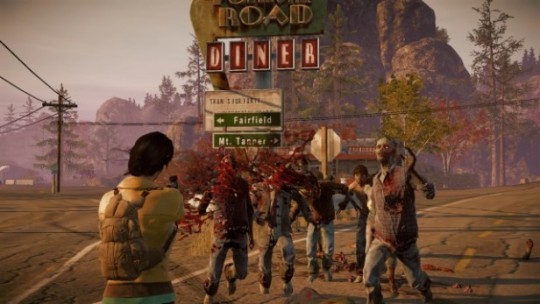
Just like in 2013’s original State of Decay, in State of Decay 2 you can freely switch between randomly generated survivors in your post-apocalyptic community – and you’ll regularly have to, because they can only be pushed so far before their stamina starts to give out. Or worse, you did something stupid and got someone permanently killed, taking their unique traits and whatever leveled-up skills they’ve acquired with them. You’re not able to customize their names or looks at all, which is a shame, because if XCOM has taught us anything it’s that it’s fun to tell your friends and co-workers how you got them killed. But that fear of loss (you can’t reload from an earlier save!) adds some significant weight to the struggle that plays out on one of three open-world rural maps, as you scavenge the region to build a shelter and work to cleanse the land of a disease known as the Blood Plague.Unlike the original, though, State of Decay 2 can be played in its entirety (after the tutorial) in four-player co-op, which even works cross-platform between PC and Xbox One. The joining parties enter the host’s game and get to bring back all their looted spoils (aside from resources) plus bonus rewards to their own game. It’s a near-universal truth that games like this become more fun when played with friends, and that holds very true in State of Decay 2.
Hot new Review Game Crew 2
Best Review Review game Plague Tale Innocence
There’s not much more to the generic post-zombie-apocalypse story than the quest to wipe out the Blood Plague – at least not that I’ve encountered in a single playthrough on one of the three maps, the Plateau – but there’s some background radio chatter that suggests a bigger world of survivors and organizations out there that could someday make an appearance. Everything else is told on a smaller, more personal scale: individual characters will have their own quest lines assigned to them, such as one woman who wanted to track down what happened to a police officer friend of hers in a series of missions, and when you eventually appoint a leader to your group, their randomly determined class appears to influence how your story ends. (Mine was a Warlord, as opposed to Sheriff, Trader, and Builder, which as you can imagine ended with lots of shooting.) But generally it’s a sandbox-style RPG where you’re tackling dynamically appearing quests as people call for help, and you make your own story in the way you deal with them.
While zombies are so omnipresent in the open world that you can hardly swing a dead cat without hitting one, they’re spread thin: next to something like Dead Rising 4 or what we’ve seen in those Days Gone trailers, the number of “zeds” you encounter in the open world at any one time is positively quaint. It’s rare to see more than a dozen at once, and the so-called “hordes” that appear on the map are limited to five or six. It’s enough to keep you on your toes, but individual zombies are more a nuisance than a threat.
Fortunately, the moment-to-moment combat against the rank-and-file undead is simple but satisfying. Melee never really evolves beyond button-mashing while keeping an eye on your stamina meter, but you can unlock some specializations that allow you to quickly throw an enemy to the ground and leave it vulnerable to a delightfully gruesome head-popping execution move. And, when you score a critical hit and knock its block off with a single swing of a bat or swipe of a machete (instead of bludgeoning them four or five times first) it’s a tiny moment of power.
Guns, which include all the expected pistols, shotguns, rifles, SMGs, and grenade launchers, feel good to fire thanks to nice loud sound effects and recoil that make them seem powerful. Ammo is scarce enough that shooting feels like a last resort, but when you skillfully execute headshots (the zombies’ spongy bodies soak up precious bullets) you’re rewarded with a chunky effect and a one-hit kill on anything shy of a hulking Juggernaut.
They’re not quite as fragile as something out of The Legend of Zelda: Breath of the Wild, but weapons do break after use, first turning yellow as a warning and then red for unusable (requiring repair in a workshop), which occasionally left me desperately improvising my way out of bad situations. You’re never entirely defenseless, thanks to an invincible backup knife, but it’s obviously less than ideal for taking on multiple enemies. That unpredictability adds some flavor to the repetitious business of clearing out zombie infestation after zombie infestation.
Driving around is a lot of fun, too, but not because cars handle well. To put it mildly, they do not – but to be fair they’re mostly beat-up vans, trucks, and sedans, with only a few muscle cars and armored vehicles mixed in. But thanks to arcadey physics they’ll always right themselves if you flip them, so you’re free to try some stupid stuff as you’re plowing through zombies and opening your door to whack them as you pass by without damaging the car’s body. It’s unfortunate that your co-op partners can’t lean out the windows and shoot at zombies while you’re at the wheel – their participation is limited to opening their own doors, if they have them.
At the same time, you have to be careful: a limited gas supply (and absolutely terrible gas mileage) adds some tension to every excursion – you don’t want to have the tank run dry just as you spot a horde hanging around with a Juggernaut, for instance. Having to keep your cars in good repair adds another layer of tension, and it’s a challenge to have to work your way out of a predicament by scrounging around for a gas can or repair kit. Also, trying to hoof it home when you’re injured and low on stamina is a big pain, especially at night.
As you use your characters, they’ll develop their skills: running a lot will build up their endurance, fighting will unlock stat boosts and upgrades to melee and shooting, and a variety of other skills like gardening, chemistry, and computers will give you access to an upgrade tree of mutually exclusive character development choices that can lead to new crafting or support ability options. These can really add up to make a character into a killing machine when they’re maxed out, so it’s worth making sure you play as a variety of characters to level them all up. Of course, this also raises the stakes of holding onto characters, as all their stats go down with them if they die.
One of the first things you do in State of Decay 2 is establish a home base – first in an abandoned home but later in a larger, more interesting location like a strip mall or theme park.The board game-style management, in which you choose which buildings to place in a set number of slots, was never all that fun for me because it doesn’t leave a lot of room to experiment. Even the largest bases I was able to find had only a few slots to build on, and most of those were taken up by essentials like beds for your people. (You could go without those, sure, but then you’ll spend all your time dealing with morale levels in the toilet or insufficient manpower.) After placing those and maybe a farm to reduce the amount of food you have to constantly forage for, you’re left with space to build only one or two crafting buildings at a time. Tearing down an arsenal to build an auto shop or an infirmary to build a workshop takes way too long to be worth messing with, since construction can take upwards of 30 real-time minutes.
0 notes
Text
Review game Moonlighter
As a couple of green slimes distract me, a flying razor-blade golem slaughters me on the third level of the aptly-named golem dungeon. My bag full of expensive iron bars and golem cores spills onto the ground with my life, with the exception of the five treasures I meticulously chose to place in the top row of my inventory grid. I was one room away from the boss before being unceremoniously tossed face-down outside the dungeon entrance. It sounds like a frustrating, wasted day, but that it isn't is my favorite aspect of Moonlighter.
I put those five remaining items on sale in my store the next morning, which nets me 20,000 gold. It’s a good profit for the current state of my shop. Moonlighter uses this slap on the wrist style punishment often, admonishing me for my arrogance without making me feel too sorry for it. The permissive attitude fits with Moonlighter’s (relatively) short completion time, making for a quick dip into the roguelike genre rather than the usual swim through a riptide.
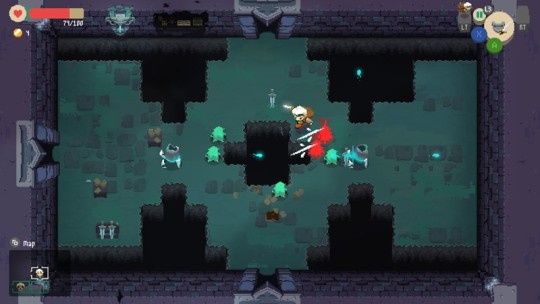
Freelance hero Moonlighter is the unlikely intersection between roguelite dungeon crawler and shop simulation that many will recognize as inspired by Recettear, the 2010 indie game from Japan that originally popularized the combination. Will, the protagonist and proprietor of Moonlighter, spends days tending his shop and nights exploring the town’s procedurally generated dungeons. Some town elder named Zenon predictably cautions Will against his heroic dreams, encouraging him to keep his nose down and make a living. I say: You do you, Will! Live your passion and don’t let any old guy stuck in his ways tell you that you have to work in customer service the rest of your life!
Will’s dream is unlocking the fifth dungeon door in his hometown Rynoka by obtaining four keys held by giant monsters in the basements of four other dungeons. Each day is split between the two primary objectives: adventuring and merchandising. At night, I enter one of the four themed dungeons, beginning with the golem dungeon and progressing each time I defeat a boss. The enemies on each floor have attack patterns that I was quick to learn, but become more challenging to track as ranged beam attacks intersect with the cadence of golem soldiers swinging swords. I was tripped up regularly, but rarely to deadly consequence.
Each dungeon, though generated new every day in roguelike style, is only three floors deep before the area’s boss, a longer fight that focuses on recognizing and anticipating a suite of dangerous attacks. The three floor structure makes death fairly stress-free. Dying on the boss’s doorstep means only 10 to 20 minutes of setback.
Combat itself is fast but not frantic. Each room takes a quick second of evaluation to determine who should be taken out first. I alternate between rolling away from attacks and darting in to poke an enemy to death with my spear. A combination of ranged and melee enemies in a room means a bit more rolling or darting behind rocks and obstacles to dispatch sword-wielders first. Moonlighter has keyboard support but recommends using a controller, a suggestion that I’ll echo for the sake of precision. The combat is all about moving around the room efficiently, easier to accomplish with analog sticks than keys in my opinion, and I get a flash of pride any time I manage to roll and dance circles around monsters without taking any damage.
Back in town, Will has the option to invest gold into Rynoka to bring various merchants in. The blacksmith upgrades weapons and armor with two possible upgrade paths for each item. The witch sells gear enchantments and consumable potions. A retailer, hawker, and banker make up the rest of the possible Rynoka main square. The depth and variety of combat upgrades are modest, another earnest but cursory exploration of dungeon-crawling.
Hot reviews Mount & Blade 2: Bannerlord
News Review game The Crew 2
Running the shop is not so tedious as a chore but not quite demanding enough to pose a challenge. In the morning, I put my hard-earned haul on display and set the prices for each item before opening for the day. Customers come and go, examining the merchandise for fair prices. Villagers react to each item they examine, hinting whether the price is fair or outlandish. As the short day changes from morning to night, I run about adjusting prices to customers’ taste, restocking, and standing at the register to press a button accepting each villager’s purchase. I occasionally have to sprint out from behind the counter to waylay a shoplifter by slide tackling them before they can make off with my There's not much to the pricing game. My time was best spent pricing high and backing down until customers were willing to buy. After finding an acceptable rate, I didn’t have much incentive to ever change it, typically selling each of my items at their most recent purchase price. The most satisfying moment is when, after backing down my price several times, a customer finally gives a good reaction and walks to the register. The profit earned is a more enticing reward than ‘winning’ the interaction. Discovering which items are most valuable entices me to hunt down precisely the monsters that drop them and adds higher stakes to properly managing my inventory while in the dungeon.
Pre-shop shuffle One of Moonlighter’s best systems is one that I initially wrote off as a gimmick: its inventory management. With limited space in my bag, prioritizing which items are worth holding on to and bringing back to the shop is key. On top of the usual inventory Tetris are the many item curses which dictate where in the bag they must be placed or effects they have on the items around them. One item curse sends an item adjacent to the cursed one back to the shop immediately after being placed. Other curses destroy adjacent items or turn them into a different artefact entirely. There’s a sense of pride in clearing half my inventory with intelligent use of curses, and losing a well-planned layout is more of a tragedy than the lost profit.
Moonlighter is, as far as roguelikes go, a quick jaunt. With four main areas and one final dungeon, my progress was only diverted to deal with my obsessive trips back to town to sell a pack full of loot to buy better weapons to fly through the dungeons faster. Despite its standard difficulty being called “hard” (and hardest being “very hard”), it isn’t excessively challenging. I say so with confidence because I’m typically a complete embarrassment in hack-n-slash combat, but even I made progress at a steady clip while turning a tidy profit. I died a couple times on “hard”, but more often due to negligence than difficulty, and I was never set back by more than an (in-game) night. The forgiving death penalties are as much part of Moonlighter's personality as the muted color schemes and plucky soundtrack.
Moonlighter is meant to be completed and set aside, not mastered and repeated like other, harsher roguelikes. Neither of its activities, the dungeon diving or shop management, are as complex or harrowing as other examples of either game type. I expect some will see this as a shortcoming. Personally, I seldom have the patience for obsessively deep hack-n-slash combat or ultra data-driven shop management. Moonlighter cuts just beneath the surface of both genres to let me enjoy the flavor of a roguelike without a lifetime commitment.
0 notes
Text
Review game Smoke and Sacrifice
Smoke and Sacrifice sees Sachi, a mother forced to give up her son, adventure into a grotesque underworld on a quest that will lead her to a darker truth.
Sachi lives in a perfect, pastoral village. The inhabitants worship a mechanical Sun Tree that powers the community with its benevolent light. Everything’s hunky dory except for one thing: prosperity depends on firstborn children being sacrificed to the Sun God via a big laser. Sachi accepted this when she surrendered her own son seven years ago, but over time she’s come to question the strange mechanics of their existence and the odd behaviour of the priests who orchestrate the ceremony.
Obviously, all is not as it seems. Smoke and Sacrifice soon casts you into a netherworld of vicious creatures where those same priests venture wearing masks and cloaks. This bleak place is home to a smoke-addled, down-trodden underclass – the Drear – who perform the menial tasks required to power the paradise above. Sachi is convinced her son is living among these dronelike people and is determined to discover the truth.
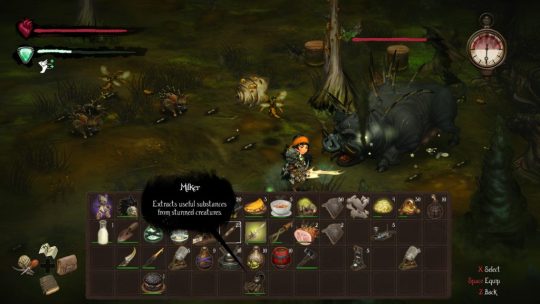
Developer Solar Sail Games drops you into a painterly landscape with no menu screen. Movement is in three dimensions, but every asset is hand-drawn 2D. The art style, animation and writing are reminiscent of the Steamworld Dig series and help to prevent the cheerless underworld from overwhelming you.
That said, it’s grim down here. Survival is the name of the game and you must explore the mire to harvest resources from plants and marauding beasts for weapons, armour, health items, upgrades and repair materials. You’ll also encounter characters and signposts bearing recipes to try out. When night comes, a purple smog billows in heralding nastier foes. Sachi wears a necklace that charges from light sources and provides nominal protection but – as with everything in Smoke and Sacrifice – it won’t last long, so crafting a lantern is priority one. You attack enemies with ‘Y’ and perform a dodge/jump with ‘X’. Hitboxes are generous, but keeping mobile is key, especially against more powerful adversaries.
Items deteriorate quickly with use, and edible goods like fruit and meat will perish. Small green bars indicate their current state and they pulse red before breaking or spoiling. Survival against slime/jellyfish hybrids and giant spinehogs depends on monitoring your inventory closely and repairing gear on-the-fly. Nobody wants their fur-lined boots disintegrating in the middle of the frozen tundra. Nightmare!
Six different biomes rub shoulders on the map, including grim woodlands, ice fields and industrial zones, each containing specific beasts and fauna. Certain workbenches and forges enable you to craft specific gear and traverse into neighbouring areas. The environments are rich with detail, although they get a touch repetitive. A map and a task screen keep you up-to-date with objectives should you get lost, and exploring the encroaching fog uncovers save terminals and a network of fast-travel tubes, plus chests to store your loot. Saves are manual and it’s vital to save often. You’ll receive a smidge of health if you’re close to death, although take care when enemies are nearby – they’ll be loitering when your save loads and we would often hear the blighters attacking us before we could defend ourselves.
Hot Review Crew 2
News Review Game A Plague Tale: Innocence
Keeping your kit in ship-shape is essential and more difficult than it need be. Inexplicably, your 4x14 inventory grid occupies less than half of the available screen space when it’s open. That’s 56 slots and, when fully laden with goodies, it can be tough to spot what you’re looking for, especially in handheld mode. As you hold ‘R’ to drag highlighted items across the grid, others shift to occupy the space you’ve just vacated, so ordering equipment is a tedious process. You can ‘favourite’ up to eight weapons and cycle through them with the shoulder buttons while fighting, but some basic sorting options would have been useful.
In a welcome move, the touchscreen is fully supported, and it’s possible to play without Joy-Cons, to an extent. Sachi moves and attacks where you tap, although dodging is unavailable, so it’s not a viable option for a complete playthrough. Inventory management is theoretically easier, although adult fingers will have trouble with the small icons. We also experienced two crashes to the Switch’s main menu during our 15-or-so hours with the game, both triggered by touch input. Not ideal, but you’ll be in the habit of compulsively saving at terminals so you’re unlikely to lose significant progress. Performance is generally steady, with some isolated slowdown occurring in later fiery areas when large groups of enemies begin attacking each other.
Smoke and Sacrifice is an attractive take on the survival genre with a diverting story examining our reliance on fossil fuels and class-dependent economies. Juggling your gear is more finicky than it should be, which is disappointing when inventory management is such a fundamental part of the game. However, if you’re prepared to keep on top of things, and you have the fortitude to brave the oppressive smoke, there’s plenty to enjoy in Sachi’s quest and the core crafting loop.
0 notes
Text
Review game Jurassic World Evolution
What could possibly go wrong when managing an island amusement park full of giant, man-eating monsters? Lots of things, though in this case they’re not the kind that lead to good gameplay. With so few interesting decisions and so much mundane busywork going on in Jurassic World Evolution, there is no need to, as Samuel L. Jackson once famously recommended, “hold onto your butts.”
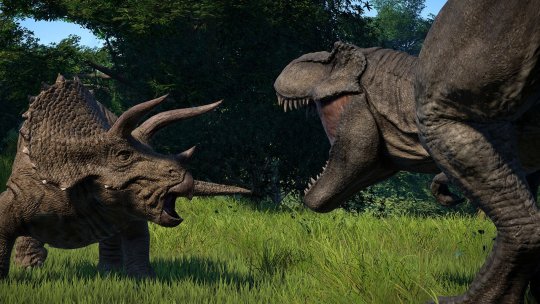
Jeff Goldblum lends his recognizable-anywhere voice to some of the narration as Dr. Ian Malcolm, and he’s clearly having a lot of fun with the pronunciation of the islands’ names – just wait until you hear him say “Isla Matanceros” in the opening flyover cutscene – but otherwise it very much sounds like his first read-through of the script. Opposite him are a handful of Jurassic World actors, including Bryce Dallas Howard and B.D. Wong, and then there’s someone voicing Chris Pratt's character who doesn’t even seem to be making an attempt at impersonating him.In this simple business sim, the idea is to build dino-zoo parks across five samey looking tropical islands, plus a samey looking sandbox island. Granted, it makes some sense for all of the islands in a region to be blanketed in the same jungles and grassy fields, but if you’ve ever been to the Big Island of Hawaii and seen how dramatically the environment can change in just a 15-minute drive – from jungle to forest to Mars-like volcanic wastelands – a little visual variety would’ve been nice.
But just like the park-going public, we’re here to see dinosaurs, and their detailed models and animations are the best thing about Jurassic World Evolution. There are 42 different species available, and watching everything from the nimble gallimimus to the lumbering brachiosaurus roam around the screen making movie-authentic noises is great the first few times. (My almost-three-year-old son absolutely loves them.)
The problem is, the process of unlocking and improving their genomes is painfully dull and repetitive, and doing it 42 times is a special kind of tedium. It almost seems like something out of a bad mobile game: You go to the map screen and click on the dots representing dig sites around the globe where you have a chance to discover fossils from a set of species to send your dig team, then wait for the roughly two-minute timer to expire. Then you go to a separate screen where you see the random assortment of fossils you’ve acquired – resembling a lootbox-style card pack – to click on the fossils to research or sell them. You only want to sell them if you’ve already fully researched that dino’s genome, or if it’s a valuable rock with no dino-DNA, so there’s no actual decision-making happening here, just mandatory robotic actions. And then you repeat that cycle, dozens and dozens of times, until you’ve done them all. I don’t know if this is intended to replicate the real paleontology work of scrubbing an unearthed fossil with a toothbrush, but if anything it’s less fun.
It’s also a let-down that, among these 42 species, there are no flying or swimming dinosaurs [Edit: fine, pterosaurs and aquatic lizards] in the mix. Without pteranodons or a mosasaurus, it’s impossible to recreate the first Jurassic World movie, even on the sandbox island. For the record, that unlimited-money sandbox mode must be unlocked, and even then you can only play with the dinosaurs and buildings you’ve unlocked in the campaign, so there’s no avoiding playing the boring part of Jurassic World Evolution, which – based on my roughly two dozen hours of play – could take upwards of 30 to unlock everything.
Once you’ve unlocked a dinosaur, you have to roll the dice to see if you get to create them. Every dinosaur has a viability percentage based on how much of their genome you’ve researched and which stat-modifying gene mods you’ve applied, and that affects whether or not they end up as a towering majestic beast or a scrambled egg brunch that cost hundreds of thousands of dollars. Bringing a long-extinct creature back from the dead shouldn’t be easy, granted, but in a game where you’re effectively gambling with having to spend more time playing a dull game to get what you want, losing that bet is just depressing.
That’s much worse here than in most similar city-builder games because, bizarrely, there’s no way to speed up time to skip long stretches of waiting for cash to roll in or dinosaurs to hatch. In everything from SimCity to Frostpunk, speeding up time avoids the doldrums of awaiting a paycheck, so even if your in-game performance (if you’re going for efficiency) takes a hit, the pace of play isn’t significantly impacted. But here, if you’re making $100,000 per minute and you want to incubate a dinosaur that costs $1,000,000 and has a 70% chance of viability, that’s 10 minutes of gameplay (in which you spend no money, so you’re doing basically nothing) you’re wagering against a 30% chance you’re going to have to spend another 10 minutes doing very little. Having played quite a bit, I’m not inclined to take that bet.
Actually building your park is basic but mostly intuitive, and the road and fence tools work well enough. Sometimes I’ve been frustrated by not being able to plop a road or building where it seems like I should be able to, but the almost completely inconsequential cost of raising or lowering ground levels (or adding or removing water or forests) to the terrain makes it pretty easy to place whatever you want wherever you want it. Power is the only resource to worry about, but you get the sense it’s only really there so they can have outages like in the movies.
Hot new Review game Plague Tale Innocence
Best review Mount Blade 2: Bannerlord
But the reason building is so dull is that most of the maps are tightly constrained, so there’s not much room for creativity. And even when there is room, there aren’t a ton of options for buildings to choose from to make a park feel like your own – at least, not until you’ve unlocked everything, by which point you’ll probably have long since grown tired of the grind of fulfilling the objectives of the three factions: security, science, and entertainment.
These three departments will pop up with objectives every so often to attempt to give you direction, but almost invariably they’re things you were going to do anyway, for rewards that are barely worth noticing. “Research a new dino’s genome up to 60%!” Yeah, I was doing that. “Increase your income to $150K!” Yes, I’m at $145K right now and in the process of placing the thing that will get me above $150K. “Sell two of these $350K-each dinosaur for $100K; we’ll give you $200K as a reward!” Well, that makes no sense, but fine, because that helps me unlock some new buildings.
Every mission you complete from one of the factions angers the other two, so you have to focus on one at a time to unlock their specific upgrades before moving to the next one. But that means the other two factions will be mad at you, and that would be very scary if the “sabotage” acts they engage in weren’t so pathetic and ineffectual. “Oh no, we’ve given three dinosaurs a disease! What will you do?” Well, I’ll send a ranger team or two to stick them with blowdarts and cure them immediately, rendering the entire thing moot. As long as there’s no coinciding storm or something equally beyond my control to randomly mess me up, I’m fine. I suppose that was true of Dennis Nedry’s sabotage as well, but John Hammond wasn’t having a good gameplay experience in that situation, either.
So most of the time, you’re sitting around performing mandatory boring tasks like ordering your jeeps to resupply feeding stations or curing random disease outbreaks. You can fill some of the downtime by taking direct control and cruising around in a jeep or helicopter, but there’s not much to do with those vehicles outside of taking photos of dinosaurs (the more appealing option for people who just want to watch these animals in action) or tranquilizing dinosaurs from the air for sport. But there’s never a “must go faster” moment because even the most ferocious-looking dinosaurs just ignore you – there’s no concept of your vehicles taking damage.
Shooting tranq darts at dinosaurs sounds like fun – and it really should be. But even when you’ve researched and equipped some upgrades for it, firing slow-moving, fast-dropping darts that reload slowly at smaller, fast-moving targets like velociraptors from a helicopter is just not fun. I found I was much better off letting the AI handle it in the event of a breakout, which it does with reasonable effectiveness once you buy the upgrades that raise the apparently deliberately annoying limitation on how many tasks you can queue up for it at once.
One of the really frustrating things about the way you’re evaluated is how it’s split between Dinosaur Rating and Park Rating. Yes, both contribute to your overall rating, which is how unlocks are doled out. But the fact that only the Dinosaur Rating determines how much money you make means you can completely neglect the Park Rating – that's everything from monorail transportation to clothes shopping and bowling alleys – until your dinosaurs are drawing in enough money that none of those things matter. I routinely set all my shops to have maximum staff and literally give away the most expensive merchandise for free to maximize their effect on park-goer happiness because the amount of money they cost is negligible after I’ve built up my park a bit. That’s just bizarre, and a broken simulation of how a park should work.
What’s sad is that that these park-goers never pipe up to let you know they’re awed by a huge apatosaurus or grossed out by a velociraptor disemboweling something in front of them makes the whole thing feel artificial. You can’t select them to see how they’re feeling at all – you just get a chart showing their overall happiness, as determined by their food, drink, shopping, transportation, and dinosaur visibility (which is in turn determined by where you place your viewing point structures). It all feels extremely artificial.
The challenge that eventually emerges in Jurassic World Evolution isn’t managing the economy, because that’s simple. It’s not hitting the simplistic mission goals that pop up, because half of the time you’re most of the way to beating those objectives before they’re issued. It’s not even repairing random storm damage, because that’s done by sending out your jeeps to instantly fix most of it. No, the tough part is jamming together as wide a variety of dinosaurs as possible in as small an area as possible without making them angry – that’s the puzzle we’re supposed to solve. And once wikis work out which dinosaurs can co-exist, in what numbers, in a pen with the same proportions of forest and grassland, that will be no problem at all.
And of course, you can have your dinosaurs fight for your entertainment and to build up their “combat infamy” rating. But when the outcome is just a roll of the dice, you get really frustrating situations like when my first $2 million T-rex was immediately killed in its first tussle with a $600K ceratosaurus. On top of that, unlike the pit fights in Middle-earth: Shadow of Mordor, you already own both combatants, so no matter who wins, you lose because you paid to incubate the loser. And even if you do have a winner who you manage to fatten up with a bunch of wins, all of your dinosaurs will die of old age sooner than you’d expect anyway, so all the effort of setting up those fights doesn’t feel worth it.
0 notes
Text
Review game Mario Tennis Aces
With what looks to be a return to form for Camelot Software's sports games prowess, Mario Tennis is back and in full swing with Mario Tennis Aces. It's the eighth installment in the series and the first game to feature a fully fleshed out story mode since Mario Tennis: Power Tour on the Game Boy Advance. It features a host of recognizable characters, multiple Tournament modes, and both local and online multiplayer. So, put on your cleats and get ready to hit the astroturf with Mario Tennis Aces for Nintendo Switch.
At first glance, the base gameplay may appear similar to that of Mario Tennis: Ultra Smash, but if the preview build I played is any indication at all, Aces looks to be a true evolution of the franchise. It's the Mario Tennis experience we all know and love, except it's fused with some fighting game elements that add an entirely new layer of competition to the core gameplay.
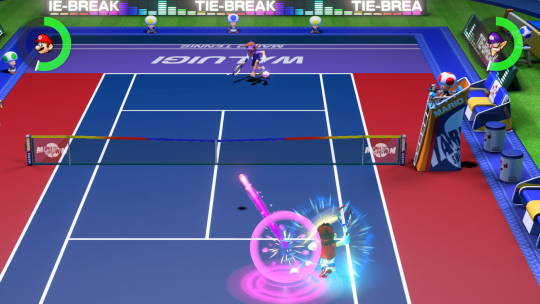
At launch, Mario Tennis Aces will offer over 15 playable characters — each with their own distinct playstyles. For example, while Mario provides an all-around balanced experience, new characters like Chain Chomp and Spike sacrifice their running speed for swing power. Characters like Waluigi and Bowser Jr. offer more defensive assets, while Yoshi and Toad are all about speed. That said, characters within the same category still hold their own unique traits. Luigi, for instance, has slightly weaker shots than Mario, but his powerful volleys are no doubt a force to be reckoned with when he's close to the net.
Each character now has an energy gauge that can be used to perform Zone Shots, Special Shots, and Zone Speed. The energy gauge can be increased by successfully returning a hit, or by performing Trick Shots — filling the gauge significantly quicker but requiring players to be extremely precise with timing. When a players energy gauge is slightly filled Zone Shots can be performed by reaching a star icon on the ground and hitting the R trigger. This allows players to take aim anywhere on the court using motion controls. However, the longer a player takes to aim, the more energy it depletes.
Zone Shots can be countered by using Zone Speed, which allows players to slow down time; giving them a much better chance at reaching a far-off shot in time. Special Shots are performed similarly to Zone Shots, but are far more powerful and require a players energy gauge to be full. Both Zone Shots and Special Shots are capable of breaking an opposing players racket, which can often result in an immediate victory for the player with the last racket standing. Players can replace broken rackets with new ones from their inventory, but they'll be forced to retire from the match when they no longer have any usable tennis rackets left. With the proper timing, both shots can be blocked, massively increasing a players energy gauge and protecting their racket from any damage.
Hot new Review game Plague Tale Innocence
Best review Mount Blade 2: Bannerlord
New Ways To Play
Unlike Ultra Smash, Mario Tennis Aces features a traditional Tournament mode where players can challenge computer opponents offline or take the tournament online with up to four players. Participating in these will provide the player with prizes, including additional playable characters and special in-game outfits. Beyond the standard base style of gameplay, Mario Tennis Aces also features a Simple Rules mode that excludes all of the new types of shots allowing for a pure Mario Tennis experience. There's also a Swing Mode that lets you use motion controls to swing your racket. That said, I wasn't able to test out any motion controls during my time with the preview build, but they appear to work similarly to how motion controls worked in Wii Sports.
Mario Tennis Aces also includes an all-new Adventure Mode, which is comprised of various missions and boss battles for players to complete. The story focuses primarily on Mario as he attempts to rescue the Mushroom Kingdom from a dark force whose powers are instilled in a unique tennis racket called the Legendary Racket. To save them Mario must travel around the island and complete various challenges given to him by classic Mario enemies like Boos and Petey Piranha. Along the way players will collect several tennis rackets that each bear unique attributes, as well as level-up Mario's stats, such as swing power and running speed.
Following Camelot's last attempt at bringing the Mushroom Kingdom back to the court, Mario Tennis Aces introduces a multitude of new gameplay features and mechanics that deliver an entirely new competitive edge to the series. Along with the addition of Adventure Mode, online Tournaments, and a variety of characters with unique playstyles — Aces looks like it's shaping up to be the Mario Tennis game fans have been waiting for.
0 notes
Text
Review Games A Plague Tale: Innocence
It’s a strange thing to be known for, but A Plague Tale: Innocence [official site] will almost certainly be That One Game With The Brilliant Rats. As soon as footage starts to spread around the internet, it’s the rats that people will settle on because they are the entire point of the exercise. With all apologies to the two kids who are the actual protagonists, sneaking through a plague-ridden medieval French city and avoiding both inquisitors and rats, it’s the swarms that steal the show. Both as a game mechanic and a technical feat, the rats are king. It makes Dishonored look like a petting zoo.
Watching a slice of Plague Tale, played by a developer, reminded me of seeing the Mardi Gras crowds in Hitman Blood Money for the first time. Games often avoid depicting large groups of moving characters, preferring to treat crowds as a single entity rather than a larger entity made up of many smaller but discrete elements. I loved that in that Murder of Crows level, a gunshot would cause groups of people to separate, splitting into their own unique patterns of panic and escape.
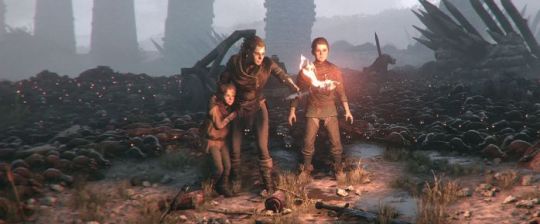
A Plague Tale, in its current form, puts its big idea right on the menu screen. A swarm of rats, each one moving dynamically, are feasting on a corpse. You can see them squirming up and around one another, nibbling and biting and fighting for space. And then, when you press start, a carriage rattles past in the street outside the building where the body is lying and its lantern sends a pool of light splashing through the window. The rats peel away from the light, scurrying and scratching, and then slowly inch their way back to the feast once it has passed.
It’s grotesquely gorgeous and explains the game’s central conceit extremely well. You play as two children, though there’s no evidence of a smart Brothers: A Tale of Two Sons style control system at this point. It looks like you’ll always, or mostly, be in control of Amicia, the older of the two, or whether you’ll also control tiny little Hugo who is about six years old. Amicia is either pre-teen or barely into her teens, but she seems capable enough, at least in the brains department, outsmarting the chaps who are hunting her and her brother. It’s a stealth game, based almost entirely around light rather than sound.
Play now Coolified games
Play more Fallout shelter mysterious stranger
Rats don’t like the light, so the darkness is often a sea of teeth and eyes. Portable light sources keep them at bay, but are hard to come by, so you’ll need to stick to what light there is in the environments, while destroying the lanterns and torches that the inquisitors carry. When you do, they’re soon covered in rats, screaming and devoured. Grim.
The small chunk of the game I saw might not actually be in the game at all, with release possibly a year and a half away or more, but as a technical demonstration it was impressive. At one point, rats pour through a church’s windows like streams of oil, flooding the floor and lapping against the flicker of torchlight that protects the protagonists. They’re fluid, like a particle system with teeth and claws, and the way that they writhe and surge adds an element of horror to what might be fairly conventional environmental light-based puzzles.
It’s too early to know whether the game will live up to its rats, but I do like seeing a mechanic directly tied to exciting tech. The historical setting has clear elements of fantasy, not least in the rats themselves, but will be mostly grounded in reality, and if the environments are depicted half as well as their inhabitants, it’ll be a beautiful game if nothing else.
Side note: developers Asobo worked on a game based on the Pixar film Ratatouille and that amuses me.
0 notes
Text
Review Games Hunt: Showdown
Hunt: Showdown wants you to feel panic. There’s the panic that ensues when the echoes of your gunshots ring out in the forest around you, potentially attracting monsters and players. Then there’s the panic of trying to franticly escape a level with a prize before other players track you down. And finally, the panic and frustration of losing one of your hunter characters who’d amassed a hefty stash of gear over multiple successful hunts, all because you were careless around a pack of zombie dogs. It’s an addictive type of panic that, when everything clicks, is wholly unique and exhilarating in a way that no other game can be.
Hunt is an Early Access first-person shooter from Crytek with a more nuanced premise than most: You (and your partner, if you bring one) are thrown into a swamp-spattered jungle with minimal supplies and the goal of hunting down and killing a twisted, demonic monster somewhere on a map full of smaller but similarly angry monsters. But it’s not that simple. Not only do you need to kill a monster, you then need to escape while evading other players. It has a very Lovecraftian-meets-Van Helsing setting, which does an excellent job of amping up the tension with some of the most realistic uses of actual darkness I’ve seen in recent memory. Instead of just being a vague, blurry, blueish filter over the screen, nighttime feels like an actual absence of light. With a quality pair of headphones, Hunt delivers the spine-tingling sounds some of the creatures make as they stalk you, and quickly becomes one of the most unnerving games out there.
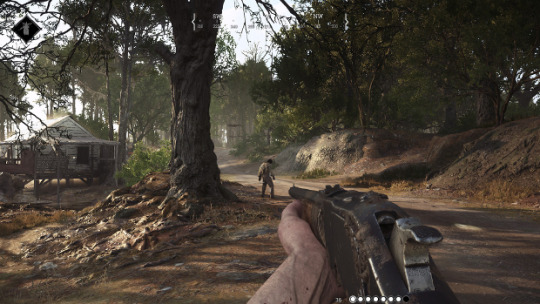
A round of Hunt consists of searching for clues, locating and killing your target, then escaping with your prize – but it’s a lot easier said than done. In its Early Access stage, the only two targets are a giant spider and a lumbering butcher who likes to set things on fire. I’ll never forget the first time I faced the butcher: I was carelessly rounding a corner in the basement of an old farmhouse and got absolutely demolished by his giant, hammer-like weapon in just a couple of smashes. We had to kite the behemoth to take him down, running away and taking quick pot shots whenever possible.
The monsters offer up a decent challenge and are fun when when all of the elements work in tandem against you. But, as they stand, the boss monsters’ AI needs a lot of work. The butcher, for example, refuses to walk through doorways, so it’s extremely easy to exploit this by running outside and blasting him in the back as he walks away. Of course, this does then run the risk of exposing you to other players waiting for you to exit the building after this trick.
But before you can fight a monster, you’ve got to track them down using your Dark Vision ability, which blacks out the world around you to illuminate a trail that leads to the nearest clue. (Naturally, with so many threats lurking, it’s extremely risky to leave this on longer than you absolutely have to.) Disappointingly, all of the clues are just blackish-blue pits that you hover your hands over for a few seconds before getting the trail for the next clue – effectively a simple pickup. In a sense, the word “clue” is a bit of an overstatement, but each one you find does narrow down the potential location of the monster.
Play more 60 seconds burger run unblocked
Hot new Cannon basketball 3
Once you locate the target, you have some important decisions to make. You can go in guns blazing if there aren’t too many enemies nearby or if you’ve got enough explosives and ammo to not care. Otherwise you’ll have to use stealth to stay hidden and carefully plan your approach to each encounter. This is where having a partner to help cover you really comes in handy.
When you’ve finally downed one of the named beasts in a partially glitchy battle, you have to banish it to Hell, a ritual which takes time and notifies everyone on the map exactly where you are. Initiating the ritual will shift other players’ tracking senses to focus on your trail instead of the monster’s, and marks your location with a map marker. It’s a clever mechanic that completely flips around the hunting dynamic. You can no longer hide and you no longer have a target to hunt as you enter full-on escape mode, which totally changes the way you play. Few games offer the same sense of exhilaration and panic as a match nears its finale in Hunt.
Whether you’re the hunter or the hunted, teamwork is crucial for covering each others’ backs. That makes playing solo incredibly difficult, to the point where Hunt is one of the few games that I actually preferred playing with a random (and often silent) partner to just going it alone. Loneliness makes Huntmore difficult, but it’s also boring since it can end up feeling like a shallow game of hide and sneak. With a partner, you’re at least emboldened to act more aggressively and decisively.
The competitive side comes from the fact that you’re constantly racing against up to 11 other hunters (with a max total of 12 in a game) to find and kill the target. But it’s more than a deathmatch -- the temptation to shoot first and ask questions later is certainly there, but it can be more beneficial to stalk other players and let them do the dirty work of thinning out enemies themselves (and take some hits in the process) before you swoop in to finish off whoever wins.
Take a look at 12 minutes of gameplay, above, with an explanation from the game's creative director on how matches ebb and flow.
By mixing cooperative and competitive elements together, Hunt creates a frantic “kill or be killed” atmosphere that leads to some truly palpable moments of tension. My first encounter with another player was about as tense as you’d expect. My partner and I were crouched down in waist-deep swamp waters, peering at our enemy as he slowly crept around the backside of a barn. We snuck up behind him and I blasted him in the back of the head with my shotgun, killing him instantly – but we’d neglected to check our surroundings first, or we’d have noticed that the farm was full of horrifying zombie-dog creatures. Though that fight didn’t end well, I didn’t regret a single second of the overall experience.
Matches typically only last for about 20 minutes, which is good because they can get boring if there is a shortage of action. You’ll spend the first five or so minutes sneaking around trying to make as little noise as possible, but that part of it just isn’t as engaging as it is in dedicated stealth games. There aren’t any specific mechanics or features that play to the stealth action -- it’s literally just large spaces with mostly oblivious AI wandering around. The introductory stealth environment felt like artificial padding to the lengthen matches where, in reality, getting straight to the action is where the game is most entertaining.
Eventually, every round in Hunt turns into a mad dash for the boss and the exit at the very end. Hunt is full of highs and lows without much in between. Part of that is due to the fact that even though it’s thematically consistent with the post-apocalyptic wasteland setting, the single map feels empty thanks to a lack of landmarks and interesting buildings. There’s barely any loot to find during matches other than ammo, which limits the desire to explore and scavenge, and the limited player count decreases the sense of mass desperation. In fact, you could play several games without ever seeing another player. Hunt does a lot of things that add much-needed terror to the genre, but it could stand to include more mechanics to funnel players together more regularly, too. Hunt’s setting may be a wasteland, but its environment and battle dynamics can frequently feel like one, too.
Some bigger problems still need solutions, too. Chief among them: there’s nothing stopping players from skipping the hunt phase entirely and camping the extraction points -- which are always in the same location-- and waiting for someone else to kill the monster and try to escape with it. Or, more ambitiously, they can simply follow other players, let them kill the monster, and then pick them off while they’re weak to steal the reward for themselves. Getting the flow of those battles right is going to be a tricky balance to strike, and Crytek hasn’t quite found it yet. It’s simply too easy to get away with this kind of profitable murder.
There are more delicate balancing issues at play. Unlike many other games of this nature, Hunt has real, tangible consequences for each death. The named hunter you were using, the guns you bought, the tools you equipped, all of his upgrades/perks, and all of his gear are lost when you die. (It’s sort of like if Escape From Tarkov and Evolve had a twisted, brutal little baby.) The only things that, mercifully, carry over are your experience points and profile level, which Hunt conveys with a bloodline system (suggesting that all of your hunters are from some sort of deranged monster-killing family). As your bloodline level increases, you unlock new tiers of gear -- like better guns, but those guns still cost money to acquire each time, and you also lose a bit of money when you die, so it all feeds back into itself.
Thankfully, your persistent account accrues in-game money over the course of playing games and completing contracts that you can use to spend on recruiting new hunters, buying new gear, and purchasing incremental upgrades. Having more than one hunter at a time can be advantageous because it allows you to keep more than one geared up so that you don’t lose all of your progress – kind of like multiple save slots. Hunters are also assigned randomized traits when you recruit them, which could make them bandage faster (with the Physician trait) or sprint at full speed for longer (with the Greyhound trait), adding some variety to each playthrough.
You’re never completely screwed: If you’re totally tapped out and can’t afford to recruit a new hunter, you can fall back on a zero-cost stand-in that you can use to try to gain back some funds. It’s a minor, but appreciated failsafe that ensures you won’t hit a brick wall of failure.
That said, the first few matches for a new player in Hunt are so difficult, they can feel like a barbed-wire fence of failure. But considering how hard it is to come by new upgrades, it would be nice to have some way to try before you buy. Blowing a bunch of money on a gun only to realize you don’t even like it, or buying a gun and getting killed before you even get a shot off is immensely frustrating.
Thankfully, your persistent account accrues in-game money over the course of playing games and completing contracts that you can use to spend on recruiting new hunters, buying new gear, and purchasing incremental upgrades. Having more than one hunter at a time can be advantageous because it allows you to keep more than one geared up so that you don’t lose all of your progress – kind of like multiple save slots. Hunters are also assigned randomized traits when you recruit them, which could make them bandage faster (with the Physician trait) or sprint at full speed for longer (with the Greyhound trait), adding some variety to each playthrough.
You’re never completely screwed: If you’re totally tapped out and can’t afford to recruit a new hunter, you can fall back on a zero-cost stand-in that you can use to try to gain back some funds. It’s a minor, but appreciated failsafe that ensures you won’t hit a brick wall of failure.
That said, the first few matches for a new player in Hunt are so difficult, they can feel like a barbed-wire fence of failure. But considering how hard it is to come by new upgrades, it would be nice to have some way to try before you buy. Blowing a bunch of money on a gun only to realize you don’t even like it, or buying a gun and getting killed before you even get a shot off is immensely frustrating.
0 notes
Text
Review Games Bloodstained: Ritual of the Night
Bloodstained: Curse of the Moon treads a thin line between homage and outright theft. Created as a Kickstarter bonus for the upcoming modern-looking Bloodstained: Ritual of the Night, Curse of the Moon taps into project's attempt to continue Castlevania's metroidvania legacy by setting its sights on that series' older, 8-bit entries. Not only does it succeed at paying the NES Castlevania games tribute, it almost does it a little too accurately for its own good.
If this game amounts to an act of plagiarism, though, at least it's self-plagiarism. After all, Bloodstained creative lead Koji Igarashi is best known for directing numerous Castlevania games during his time at Konami. He served more as a supervisor here than director, but you can definitely see his fingerprints on Curse of the Moon; he even appears as a mini-boss. On top of that, the credits list several other long-time Castlevania contributors, such as composer Michiru Yamane. If this game amounts to Castlevania in all but name, that's because Castlevania is what its creators know.
Curse of the Moon conspicuously borrows critical mechanics and concepts specifically from 1990's NES classic, Castlevania III. It allows you to alternate between four different playable characters, each with their own distinct skills and attack styles, as you fight your way through eight linear stages packed with monsters and platform hazards. They're practically spitting images of Castlevania III's playable characters, from Gebel the vampire (who throws fireballs and transforms into a bat, like Castlevania's Alucard) to Arthur the wizard (who swings a puny staff and controls overpowered magic, like Castlevania's Sypha). Curse of the Moon moves a little faster and feels more forgiving than Castlevania III, making it feel more modern than the slow-moving 90s games, but there's absolutely no mistaking the intent.
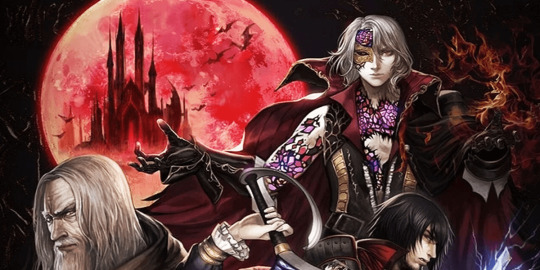
While at times Curse of the Moon may drift a little too close to naked imitation in its attempts to channel a nearly 30-year-old game, it works on its own merits, too. It introduces new features and quality-of-life design elements, and it offers a wide array of difficulty options in order to provide a satisfying yet manageable challenge for players of all skill levels.
Rather than taking so mundane an approach as making things harder by ratcheting up enemy endurance or hit points, Curse of the Moon elevates its difficulty by introducing material changes to its play mechanics. The most basic upgrade in difficulty introduces limited lives for your party and adds a knockback element to create an extra bit of danger when you take damage from foes. But there are more interesting challenges to understand, such as the two alternate paths in which main protagonist Zangetsu tackles the quest alone, forcing you to adopt completely new tactics for battling the bad guys. Completing the campaign opens up additional new play options as well.
Play now Quad Blocks
Play more 123games
Even before you apply modifiers, there are a lot of ways to tackle Curse of the Moon's eight stages, and each level contain multiple routes to the end. The variety created by these branching paths and play options, and the bone-breaking old-school challenge available in certain formats, give Curse of the Moon far more replayability than its brief, two-hour length would suggest.
Curse of the Moon’s title hints at the exploratory, perfectionist mentality its creators seem to want to encourage. The term "Curse of the Moon" appears in-game as a cryptic menu option, and selecting it allows you to jump back to previous stages. This permanently resets your progress to that earlier point in your adventure, erasing all your saved accomplishments beyond the stage you select. In return for permanently sacrificing your progress, though, you gain the opportunity to poke around the different pathways through a level in search of better acquisitions. Each stage contains hidden items that permanently boost your heroes' stats that you'll want to seek out. On top of that, gathering collectibles to rack up extra points is essential to earning additional lives in the more advanced difficulty modes. In other words, it's not enough to simply complete a stage, challenging as that can be at times; what you really need is to master it inside and out.
Developer Inti Creates has done an excellent job of capturing the look and feel of NES games without being slavish to the limitations of the platform. Your characters are a little less stiff than the NES heroes of old, a little faster to react, a little more fluid in motion. And although the widescreen format creates larger rooms to navigate than in the days of 4:3 aspect ratio and 8-bit screen resolution, Curse of the Moon compensates for this by throwing more enemies at you at a time or by making them move faster.
Fans of Shovel Knight will likely be reminded of that game's outstanding approach to recapturing the look and feel of the NES era. Curse of the Moon doesn't quite reach that remarkably high bar; it lacks Shovel Knight's meticulous level design and surprising variants on standard enemies. The basic foes you face here never stray far from the Castlevania mold, relying on familiar concepts like Medusa heads flying in tricky sine patterns and armored knights tossing axes. They look different, sure, but this is the standard Castlevania bestiary with swapped sprites.
On the other hand, the bosses feel nothing like Castlevania. In fact, they highlight what might be the biggest flaw in this retro homage: inconsistency. Where Shovel Knight used Mega Man as a jumping-off point to become something truly its own, Curse of the Moon feels less confident in itself. The moment-to-moment action feels mostly like a Castlevania fan game, true. However, the boss encounters (along with a few set pieces, such as the trial-and-error gimmick that dominates the final stage) feel more like they were taken from Inti Creates' work on the likes of Mega Man Zero and Blaster Master Zero. For every boss that amounts to a fun riff on Castlevania favorites, like the tribute to Rondo of Blood's battle with Death atop the mast of a ship, there are several encounters that feel wildly out of keeping with the source material.
Curse of the Moon’s shortcomings aren't limited to quirks of style. Most notably, the death mechanic feels more clever than fun: when one of your team members dies, they're taken out of the action altogether until you complete the current stage or lose the entire team. This mostly serves to punish you for making use of your favorite protagonists, since you're always a single false jump or unlucky knockback away from losing the one you enjoy controlling most. We see lots of devs tinkering with the penalty for failure in retro-style games lately, but this is one of those cases where the idea doesn't work quite as well in practice as it does on paper. Like WayForward's recent The Mummy Demastered, death in Curse of the Moon often punishes you with tedious inconvenience. On the whole, however, these missteps prove to be fairly minor.
The Verdict
The prospect of playing such a lovingly crafted tribute to the vintage heyday of Konami's seemingly abandoned Castlevania series more than makes up for a few out-of-place boss fights and a slightly too punitive death penalty. Bloodstained: Curse of the Moon delivers a brief but effective burst of nostalgia, and thanks to its many creative modifiers it contains enough replay value to engage (and challenge) anyone who pines for gaming's bygone days. And this isn't even the "real" Bloodstained! As appetizers go, it's substantial — nearly satisfying enough to be its own main course.
0 notes
Text
Review Games Call of Cthulhu
Even the Old Ones themselves would have probably lost patience waiting for Call of Cthulhu: Dark Corners of the Earth to finally show up. First unveiled more than six years ago, this horror-themed action adventure based on the work of influential American horror writer H.P. Lovecraft is clearly ambitious, mixing first-person action, sneaking, and adventure elements with a creepy story filled with various surprises. The good news is that all the delays have resulted in a one-of-a-kind game that fans of horror and action adventure gaming (and of H.P. Lovecraft) absolutely should check out. However, the presentation looks somewhat dated at times, and some other aspects are also pretty rough, just like the Xbox original released six months earlier. But if you can tolerate a few technical deficiencies and are up for a significant challenge, then you can look forward to Call of Cthulhu mightily impressing you and freaking you out equally in turn.
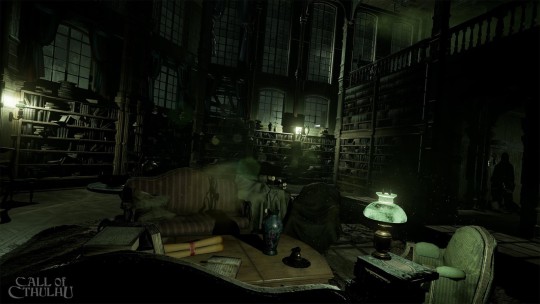
This is essentially the same game as the Xbox version, with the key differences being that the PC version supports higher resolutions and its mouse-and-keyboard controls are slightly more responsive. It also retails for a lower price. You play as Jack Walters, a private investigator with a history of mental instability. But he's fine now, honest. Jack is trying to get his life and his career back on track, but he just can't seem to remember a six-year period from his past. Soon after the opening of the game, a missing-persons case takes Jack's attention away from his own predicament. He finds himself in the quiet port of Innsmouth, a little-known shantytown with a rather standoffish populace. It's a dismal place on first impression, filled with rundown buildings and thuggish residents who gurgle veiled threats in response to Jack's inquiries. Before long, Jack begins to uncover a sinister secret lurking just beneath the surface. He asks one too many questions and soon finds himself fighting for his life against unspeakable horrors. The game does a great job of gradually magnifying the sense of danger and the scope of the mess that Jack has gotten himself into, and it also does pretty well at evoking the early-20th-century period in which the story takes place.
You don't need to be familiar with Lovecraft's stories or the Cthulhu mythos in order to enjoy this game. In fact, the experience will be all the better if you go into it without any real sense of what you're in store for. H.P. Lovecraft is best known for horror stories that attempt to describe the indescribable--horrifying things that can make a man go mad just from looking at them. Call of Cthulhu: Dark Corners of the Earth captures the essence of Lovecraft's work by presenting the entire game through Jack's own eyes, and by incorporating various elements that simulate how fleeting Jack's sanity can be when faced with terrible sights and realizations. It doesn't help the poor guy's case that he tends to have out-of-body experiences from time to time, which let him briefly see the world through the eyes of some rather strange beings. The game also intersperses some choice quotations from Lovecraft, as well as some well-written journal entries and other light reading that helps set the stage for what's happening. Ironically, if any aspect of the presentation doesn't really fit, it's Jack himself. It's his voice in particular, since he sounds like a matter-of-fact private detective...only, his rather calm demeanor isn't consistent with how he's supposedly being driven half mad by what's happening around him. The voice performance itself is fine, but it's too bad Jack sounds so brave.
Call of Cthulhu: Dark Corners of the Earth looks like it's a first-person shooter, but it combines action and adventure elements in equal parts (fans of the Thief, Deus Ex, and System Shock series will be in store for a similar kind of game). In fact, for a large portion of the game, Jack is unarmed, and he'll need to make progress using his detective work rather than his brawn. The game is probably at its best when no shooting is involved, since the shooting portions aren't that great. Your enemies will sometimes use cover when attacking you, but they don't behave very believably in battle, and their bodies quickly vanish when killed. It's a long time before you get into any pure action in Call of Cthulhu, and when it happens, it's at once thrilling and a little disappointing--thrilling because there's been so much buildup and tension leading up to the fighting, and disappointing because the foes you're facing aren't as cunning as you'd hope. Fortunately, the game rarely attempts to create challenge just by thrusting you into first-person shooter sequences, and the shooter portions are at least decent. The period weapons you'll get to use, such as Tommy guns and revolvers, feel like they pack a mean punch.
Play now Golf abcya
Hot new Bgames com
The stealth portions are pretty good, too, especially because the game never flat-out forces you to be stealthy--it's just a means to an end, useful for avoiding combat (such as when you're unarmed) or getting the drop on your enemies. But if you're spotted, you can always fight...or run. Later in the game, you'll get to perform some highly gratifying stealth kills by plunging a knife into the backs of unaware opponents, who totally deserve it, by the way. All throughout, though, you'll be able to avoid confrontation by sticking to the shadows and keeping a low profile. You may also peek (and shoot) around corners in your efforts to stay safely out of sight.
Others have tried, but Call of Cthulhu is one of the first games to date to succeed at presenting a completely clutter-free first-person viewpoint. There are no health bars or ammo counts or anything to get in the way of your suspension of disbelief, yet the game still provides sufficient visual and audio feedback to keep you informed while playing. While there will probably be times when you'll wish the game were a bit more transparent about telling you when your health is low or when you're in danger of being detected by enemies, Call of Cthulhu's invisible interface definitely is to the game's credit. There isn't even an aiming reticle for any of the guns--you just aim down the sights to line up your targets. And you know you've taken damage when you see spurts of blood along the edges of the screen, and subsequently start to hear Jack gasping in pain and losing color vision. You can even have your limbs broken--you'll cringe listening to Jack trying to walk with a busted leg. Fortunately, he's got first aid kits to bring him back into shape. First aid takes a few seconds to apply, so you can't use your kits in the middle of a fight, but you can use them in a safe spot to cure fractures, bullet wounds, and so on. No, that's not realistic, but it's a good-enough system that's in keeping with the spirit of the game--Jack can't survive much damage in the first place.
Call of Cthulhu also features heavy adventure elements, in the form of exploration and puzzle-solving. A couple of puzzles involve pattern recognition while others simply require you to use the right inventory objects in the right places. The puzzles aren't very difficult, but when combined with the game's rather large and complex environments, they can make it tough to figure out how to proceed. You don't have a map in Call of Cthulhu, and there's no mission-objectives screen or anything like that, so it's possible that you might get confused and disoriented at times--yet even this is roughly in keeping with the feel the game is trying to evoke, unless you become too frustrated or completely stuck. Fortunately, the plot and premise is compelling enough that it's worth suffering through the occasional tight spot. It's all the more exciting and satisfying when you finally get past those parts and set foot in new territory.
The game also deserves praise for creating some truly harrowing chase sequences. For whatever reason, horror games tend to be heavily focused on combat, but the scariest things are the ones that force you to flee. While Call of Cthulhu's escape scenes are scripted to play out a particular way each time, they absolutely make you feel desperate to survive. To slow down your foes, you're able to bolt doors, which buys you precious seconds as you continue your escape. The music swells to a crescendo and your enemies' screams are deafening as you scramble to find a way out. These escapes are definitely some of the moments that stick out the most vividly in hindsight.
Call of Cthulhu has a lot of great moments in it, actually. You view the action through Jack's eyes practically the whole way through, so all the game's noninteractive cutscenes are still done from a first-person viewpoint, where you see Jack manipulating various objects and so on. Some of these interactions are amazingly lifelike in a subtle way, like how Jack gingerly manipulates the combination lock on a safe, for instance. So it's a bit of a shame that these bits tend to switch to a grainy letterboxed view, which informs you that you no longer have control for the moment and takes you out of the experience. And for all the great attention to detail, it makes you notice things you might take for granted in other games, like how Jack doesn't put away his gun when he climbs a ladder, or how you can't see your feet when you look down. Nevertheless, Call of Cthulhu is much more convincing than many other first-person games in how it makes you feel as though you're really there in the environments. When you reach some of the later stages, you'll truly get the impression that you're exploring places that no normal person was ever meant to find.
You'll also feel sorry for Jack, who goes through an awful lot, all the way up through the game's disturbing, fittingly Lovecraftian ending. As he begins to see the truth behind the Esoteric Order of Dagon--the religious cult that seems to have Innsmouth under its complete control--his sanity will be threatened. Specifically, your vision will start to blur if not swim, and you'll start hearing Jack muttering to himself or his teeth chattering. These purposely distracting effects are well done and help make some of the game's bigger confrontations all the more bewildering. The sanity effects are temporary and tend to dissipate quickly if you find one of the game's save points, which take the form of unusual white glyphs painted on certain walls. These glyphs look ominous, but in a testament to how effectively creepy Call of Cthulhu can be, you'll catch yourself breathing a sigh of relief whenever you spot one of these safe havens. You might still be frustrated by the limited save system, which is a holdover from the Xbox version. Not only can you not save your progress except at these certain points, but you also have a limited number of save slots to work with. However, the limited save system is probably for the best, since being about to quicksave your way through a game like this would sap a lot of its tension.
What the game lacks in high-fidelity graphics it makes up for with surprising variety. Character animations are sometimes a little choppy, textures are noticeably blurry, and weapon models look plain, so you might catch Call of Cthulhu looking like a second-rate shooter from time to time. Much more often, though, you'll find a lot of great little touches in the environments, which are surprisingly expansive in spite of how much there is to see and do in them. Unfortunately, Call of Cthulhu lacks support for wide-screen resolutions, which would be perfect for viewing a cinematic game such as this. But the game manages to look great anyway, thanks to excellent art direction that results in some highly atmospheric locales. You could easily imagine that had it been released a few years ago when it was originally supposed to, it would have looked amazing. Luckily, the visual style still succeeds at drawing you into the experience, even despite some graphical holdovers from the Xbox, like the ugly, low-res inventory system.
The noticeable repetition in Jack's and his enemies' dialogue is the main knock against the often-outstanding sound. As mentioned, Jack's narration isn't a perfect fit for the circumstances, but most of the speech throughout the game is delivered convincingly, and Jack's enemies sound especially good. Gunfire is piercingly loud, and various ambient effects help thicken the atmosphere. There's also some great music throughout Call of Cthulhu, which tends to cue up nicely with whatever's happening onscreen.
Jack Walters' journey to the dark corners of the Earth should take you at least a good, densely packed 10 to 12 hours, but it could easily take more, depending on how long the tougher bits stump you. You then unlock a tougher difficulty mode (there's still another one to unlock after that), which heightens the challenge by making ammo scarcer and enemy encounters harder to survive. The game also ranks you based on how quickly you reached the end, how often you saved your progress, and other factors, in case you want to pay another visit to Innsmouth and its outskirts. So there's some value in revisiting the adventure--but your first time playing through Call of Cthulhu: Dark Corners of the Earth is liable to leave a lasting impression no matter what.
0 notes